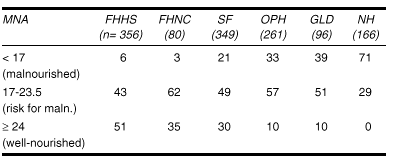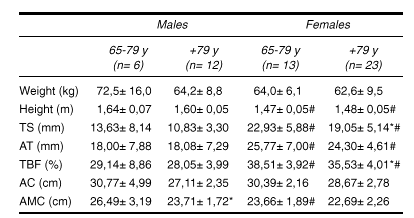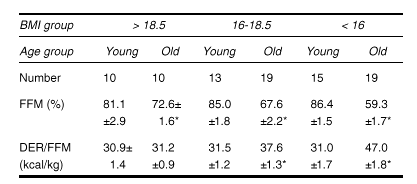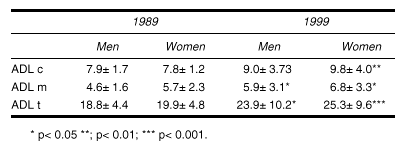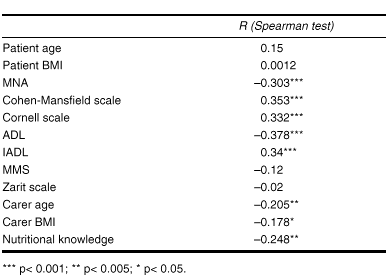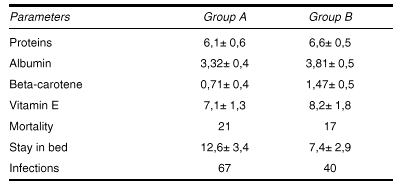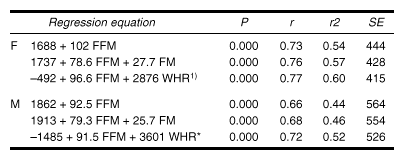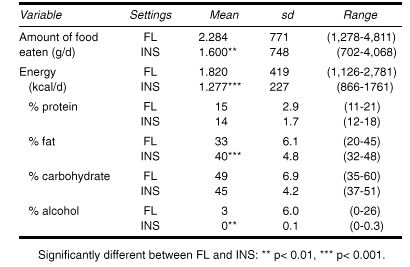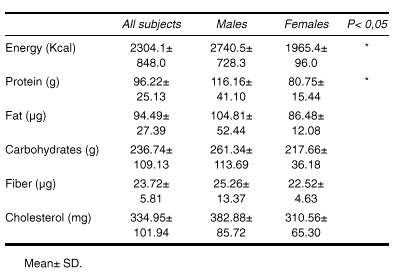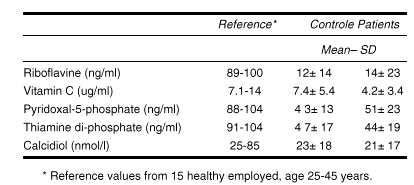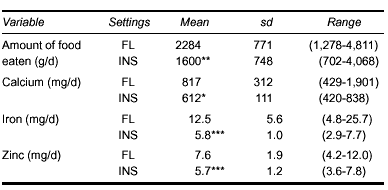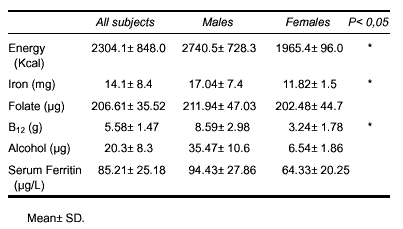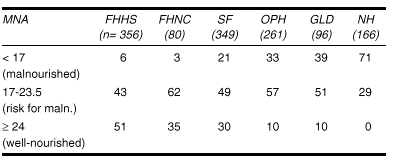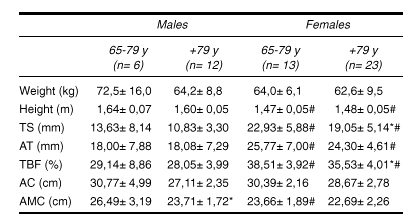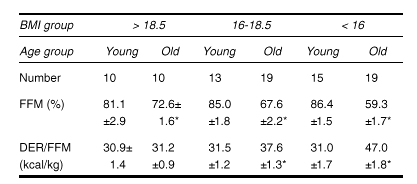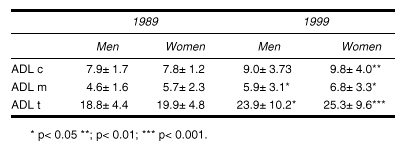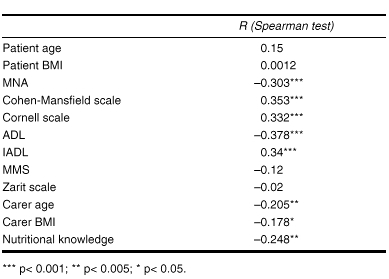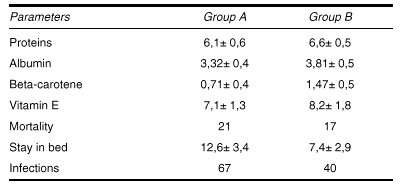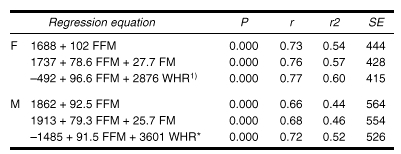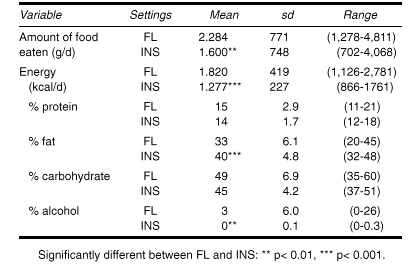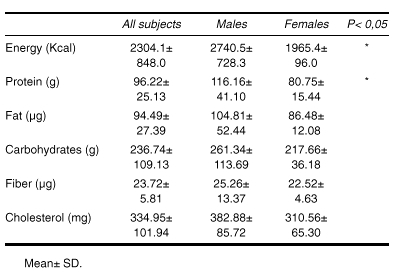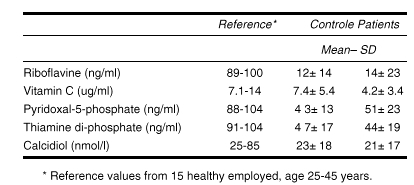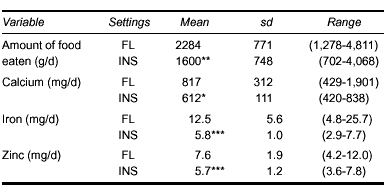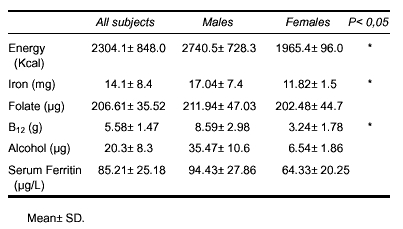21
TEN YEARCHANGES IN ANTHROPOMETRIC CHARACTERISTICS OF ELDERLYEUROPEANS
De Groot,C. P. G. M; Enzi, G.; Mattijs, C.; Moreiras, O.; Roszkowski, W.;Schroll, M., for the SENECA investigators.
* WageningenUniversity. Nutrition and Epidemiology. Wageningen. NL.
Objective: Assess longitudinal changes in height, bodyweight and circumferences in elderly Europeans.
Design: Longitudinal study including baselinemeasurements taken in 1988/1989 which were repeated in1999.
Methods: Baseline and finale data were collected in 10European research towns: Hamme/B, Roskilde/DK, Haguenau/F,Romans/F, Padua/I, Culemborg/NL, Vila Franca de Xira/P, Betanzos/E,Yverdon/CH, Marki/PL.
Usingstandardized methodologies data were collected from a randomstratified sample of elderly men and women born between 1913 and1918 including a total of 662 subjects in 1999.
Resultsand conclusion: At most sites stature had decreased by 1-2 cm.Mean weight changed by 1.2± 6.0 kg in men and by1.7± 6.3 kg in women. Average serial changes incircumferences differed. Mean arm circumference slightly decreasedover time, whilst circumferences of waist and hip increased. Themeaning of these changes in relation to health and survivalrequires further analysis.
So farpreliminary findings revealed increased mortality in underweightelderly SENECA participants.
22
GEOGRAPHICAL VARIABILITY IN ANTHROPOMETRIC MEASURES INITALIAN ELDERLY. RESULTS FROM ILSA (ITALIAN LONGITUDINAL STUDY ONAGING)
Pisent,C.; Perissinotto, E.; Inelmen, E. M.; Maggi, S.; Sergi, G.;Grigoletto, F.; Enzi, G. for ILSA working Group.
Department ofMedical and Surgical Sciences. University of Padua. Padova.Italy.
The aim ofthe study was to evaluate differences in anthropometric data fornutritional assessment in Italy. We used the cross sectional phaseof a multicentre longitudinal study on ageing (ILSA by CNR). Asample of 5462 subjects aged 65-85 years was randomly selected fromeight municipalities, representing North, Centre and South ofItaly. For 3356 subjects (62%), besides information about healthstatus, anthropometric measures were reported. All measures weredescribed by sex and age groups. A sex and geographic locationspecific description was also performed. The comparison betweenanthropometric characteristics of our subjects and those ofEuropean population confirmed older Italians are in the middle orlower part of the distribution. Mean weight (kg) ranged between74.6 (± 11.2) in the younger and 66.7 (± 10.7) in theolder for men. In women the mean weight ranged from 66.2 (±12.0) to 60.0 (± 11.7). Stature (cm) varied between 167.1(± 7.5) and 162.7 (± 7.2) for men; in women the rangewas from 154.1 (± 6.7) to 149.3 (± 7.0). Mean BMI(kg/m2) varied from 26.7 (± 4.2) to 25.2(± 3.6) for men and from 28.0 (± 5.2) to 27.1(± 5.8) for women. All the anthropometric measuressignificantly differed among the eight Italian municipalities ineach sex. Stature showed a similar geographic trend from North toSouth both in men (169.0± 7.3 to 161.7± 6.6) and inwomen (156.8± 6.7 to 148.1± 5.7). Prevalence ofundernutrition (BMI ≤ 20) varied from 1.5% to 5.0% for men, andfrom 1.5% to 9.6% for women. Obesity prevalence (BMI ≥ 30)ranged from 10.9% to 21.9% for men and from 17.7% to 45.5% forwomen. The geographical variations observed suggest that nationalreference data for nutritional assessment might be notrepresentative of all populations.
23
EVALUATIONOF THE NUTRITIONAL STATUS IN CHRONIC HYPOXEMIC ELDERLYPATIENTS
Galache,G.; López, M. A.; Pérez-Llamas, F.; Garaulet, M.;Fardy, P. S.; Zamora, S.
DepartmentPhysiology and Pharmacology. University of Murcia.Spain.
The purposewas to evaluate nutritional status in chronic hypoxemic patientsfrom the Vega Baja Hospital, Alicante, Spain, who were ambulatoryand clinically stable. Subjects consisted of 42 male patients, meanage 69± 10 yrs, with some type of ventilatory support.Hematological and anthropometric parameters weremeasured.
The resultsindicate that total proteins (TP), albumin (AL), creatinine (CT)and transferrine (TF) were normal and that undernutrition in theprotein-visceral compartment was not present. Furthermore, uponanalyzing anthropometric data, this population could be defined asoverweight (BMI > 27 kg/m2) and obese, according totriceps skinfold data of the Spanish population (> 95thpercentile).
Taking intoaccount that underweight and overweight patients are bothconsidered malnourished, some by deficit and other by excess, it isconcluded that, contrary to the conclusions of prior studies,patients from the Vega Baja Hospital from the south of Spain arenot undernourished, but rather are malnourished because ofoverweight and obesity.
24
BODY FATDISTRIBUTION IN PRE- AND POST- MENOPAUSAL WOMEN: METABOLIC ANDANTHROPOMETRIC VARIABLES
Garaulet,M.; Pérez-Llamas, F.; Baraza, J. C.; García, M. D.;Fardy, P. S.; Tebar, F. J.; Zamora, S.
DepartmentPhysiology and Pharmacology. University of Murcia.Spain.
The aim ofthe study was to compare body fat distribution and metabolicvariables in pre- and post-menopausal women. The study wasconducted in 55 obese female subjects (22 pre- and 33post-menopausal) with body mass indices (BMI) from 27 to 35kg/m2. Body fat distribution was measured using waistand hip circumference and computerized tomography. Hormones such asestradiol, testosterone, androstenedione, dehydroepiandrosterone,insulin and leptin, as well as plasma lipids as triglycerols, totalcholesterol, HDL-C, LDL-C, apoprotein A and B, were alsodetermined. No significant differences were found between the twogroups in BMI, percentage of body fat, waist circumference,triceps, biceps, suprailiac and abdominal skinfolds. Hipcircumference, subscapular skinfold and subcutaneous abdominaladipose tissue area were significantly lower and waist-hip ratio,visceral area and visceral to subcutaneous area ratiossignificantly higher in post-menopausal women (P< 0.001). As wasexpected, basal plasma estrogen was significantly higher inpre-menopausal women, while insulin was lower (P< 0.01). Whencomparing plasma lipids, blood cholesterol and LDL-C values weresignificantly higher in the post-menopausal group (P< 0.05). Inconclusion our data suggest that body fat distribution changesaccording to menopausal status, with central obesity morepronounced in post-menopausal women. Metabolic abnormalities arerelated more to visceral adipose tissue and estrogen plasma levelsthan to BMI.
25
OVERWEIGHTIN ELDERLY MEXICAN WOMEN OF A MARGINAL COMMUNITY
Gutiérrez, R. L. M.*; Llaca, M. C.*; Cervantes, T.L.*; Velázquez Alva, M. C.**; Irigoyen, M. E.**; Zepeda,M.**.
* Clinica deGeriatría. Instituto Nacional de la NutriciónSalvador Zubirán. Departamento de Atención a laSalud. ** Universidad Autónoma Metropolitana/Xochimilco.Mexico.
Obesity is amain risk factor in the development of diseases which are causes ofdeath in elderly population. Socio-economic characteristics had animpact in the prevalence of obesity. The purpose of this study wasto estimate the prevalence of obesity in elderly Mexican womenliving in a marginal community and compare their results with thoseof women of urban and rural areas in Mexico. The study has a crosssectional design. The measurements were carried out by standardisednutritionist. The international techniques recommended were used tomeasure weight and height. To estimate the proportion of overweightand obesity, the body mass index (BMI) was used following the WHOcategories. A total of 249 elderly women were examined. The meanage was 71.6 (sd 7.8). No difference in age was found in the threecommunities visited (p< 0.05). The mean BMI in the urban womenwas 26.7 (sd 4.6), in the rural 24.5 (sd 3.9), and in the marginalgroup 28.6 (sd 5.5) (p< 0.0001). The proportion of overweightand obese women was in the urban group 60.7%, in the rural 36.2%and in the marginal women 76.5% (p< 0.0001). The results of thisstudy indicated the presence of a high prevalence of overweight andobesity in elderly women of urban and particularly in the marginalareas. Marginality seams to be a risk marker of obesity in elderlywomen in Mexico. Intervention programs aimed to decrease theprevalence of obesity and improve nutritional condition in thisgroup are urgent.
26
MININUTRITIONAL ASSESSMENT IN FREE-LIVING AND INSTITUTIONALIZED SWEDISHELDERLY
Saletti,A.*; Johansson, L.*; Cederholm, T.**.
* SwedishNational Board of Health and Welfare. Stockholm. ** Department ofGeriatric Medicine. Huddinge University Hospital. Huddinge.Sweden.
Objectives: The nutritional status in free-livingelderly with home help service (FHHS) and with home nursing care(FHNC), and in elderly in assisted accomadations, i.e. serviceflats (SF), old peoples homes (OPH), group living for demented(GLD) and nursing homes (NH) was studied.
Methods: Out of 1589 subjects, 1308 were assessedaccording to the Mini Nutritional Assessment (MNA) scale (0-30points), which consists of 18 point-weighted registrations, e.g.body mass index (BMI, kg/m2).
Results: The average age in the populations ranged from82± 7 to 84.5± 8 years. The table shows thepercentage malnourished, risk for malnutrition and well-nourishedsubjects in the various populations.
BMI < 20was found in 15-34% of free-living elderly and in 18-33% of thosein assisted housing.
Discussion: More than half of the elderly with variousforms of community support were assessed as having suspected orconfirmed malnutrition. Further studies are necessary to assess towhat extent these nutritional disturbances arereversible.
Nutritionalroutines in old peoples care within the community may need morefocus.
27
CHANGES INBODY COMPOSITION DURING ELDERLY
Rozas,E.*,**; Abecia, L. C.**; Portillo, M. P.*.
* Nutritionand Food Science. ** Epidemiology and Public Health. Faculty ofPharmacy. University of País Vasco. Vitoria.Spain.
Bodycomposition is crucial to evaluate nutritional status. The aim ofthe present work was to assess changes in body composition duringelderly, in both males and females.
The study wascarried out in 54 institutionalized old persons (18 males and 36females). Weight was measured using an electronic weighing scale,height using a stadiometer, arm circumference (AC) using anantrophometric tape and tricipital (TS) and abdominal (AS) skinfoldthickness using a Holtain caliper. Arm muscle circumference (AMC)and total body fat (TBF; %) were calculated according to Frisanchoand Durning & Womersley respectively.
# Significantly different from males; * Significantly differentfrom people aged 65-79 years, P< 0.05
Whencomparing females aged more than 79 years with those aged 65-79years a significant decrease in total body fat, due to peripheralfat but not to central fat, was observed. In males total body fatwas maintained but muscular mass was reduced, reaching similarvalues than those shown by females aged more than 79years.
28
NUTRITIONAL CHARACTERIZATION OF INSTITUTIONALIZED VENEZUELANELDERLY
Peña, E.; Meertens, L.; Solano, L.
Centro deInvestigaciones en Nutrición. Facultad de Ciencias de laSalud. Universidad de Carabobo. Valencia. Venezuela.
In order tocharacterize anthropometrical and biochemical variables of elderlypopulation, according to age, sex, and nutritional status, 31 menand 32 women, aged 60 or more years (77.2± 7.4 y), from ageriatric home from Valencia, Venezuela, were evaluated.
Weight,height, circumferences (AC), skinfolds (TSK), fat area (FA), musclearea (MA), and body mass index (BMI) were determined. Hemoglobin,lymphocyte count, albumin, transferrin and serum cholesterol weremeasured. According to age, two groups were built: < 80 y and> 80 y. By BMI, three groups were identified: low weight: <22.0, normal: 22.0 a 26,9 and overweight: ≥ 27.0kg/m2. Descriptives statistics, student t test and ANOVAwere performed.
60.3% of theelderly were < 80 y old, and 47.3% were male, while 39.7% of theelderly were older than 80 y and 52% were male, with no significantdifferences in distribution by sex. 32% of the elderly wereclassified as low weight and 38% as overweight, with 75% of male aslow weight and 79% of women as overweight (Chi2:13.6,p< 0.001). Men had significantly lower values of BMI, AC, TSKand FA (p< 0.001). Proportion of elderly with abnormalbiochemical parameters were 9.5% for hemoglobin, 9.5% forlymphocyte count, 31.7% for albumin and 17.4% for cholesterol andtransferrin respectively.
These resultsshow the great variability among anthropometric and biochemicalvariables, indicating that as aging advances, nutritional riskincreases. More research is needed in this area with the aim ofobtaining representative information on this populationgroup.
Funded by:Consejo de Desarrollo Científico y Humanístico de laUniversidad de Carabobo, Venezuela.
29
WEIGHTREPRESENTATION IN ELDERLY
Conson,M.; Ricci, M. T.; Petrillo, B.; Messina, G.; Ranucci, S.; Leone,S.; Chieffi, S.; Mangoni Stefano, C.
Department ofHuman Physiology and Integrated Biological Functions. Faculty ofMedicine and Surgery. Second University of Naples. Naples.Italy.
In thepresent study we have examined how elderly and non-elderly subjectsevaluate their weight. The subjects were divided in four groups:overweight elderly, obese elderly, overweight non-elderly and obesenon-elderly. Subjects were asked to refer both their height andweight. By using these values we calculated the referred BMI(rBMI). The rBMI was confronted with the real BMI (BMI).
The subjectswere also required to indicate which weight they hoped to reach. Byusing this last value we calculated the desired BMI (dBMI). Theresults showed that rBMI was significantly lesser than BMI in allthe groups. However no diferences in underestimation were foundamong the groups. As to dBMI, the 50% of overweight elderly and 85%of overweight non-elderly desired to reach a normal weight; and 12%of obese elderly and 43% of obese non-elderly desired to reach anormal weight. These findings suggest that normal weight representmore frequently the target to reach in non-elderly than inelderly.
30
MENOPAUSE:HORMONAL REVOLUTION OR FEMALE ELDERLY START?
Farzati,A.; Messina, G.; Tamborino, R.; Liccardi, G.; Mangoni Stefano, G.S. M.; D'Ambrosio, L.; Colacurci, N.; Mangoni Stefano,C.
Department ofHuman Physiology and Integrated Biological Functions. Faculty ofMedicine and Surgery. Second University of Naples. Naples.Italy.
Objective: To evaluate body composition in fertile andmenopause women.
Patients: 100 healthy women were selected; then womenwere divided into two groups: fertile (50; mean age 47.7±4.8 and menopause (50; mean age 47.0± 5.0). The groups hadsmilar BMI (28.3± 0.2) and weight (68.3± 0.2Kg).
Methods: Our data were homogeneous in every group. Weobserve a different body composition between fertile thenmenopausal group; the mean total water, in fact appears higher infertile than menopausal group (32.9 Kg vs 32.4 Kg); of greaterinterest seems to be water distribution between intracellular andextracellular compartment: the intracellular compartment in fertilegroup is higher than menopausal group (20.2 Kg vs 19.1 Kg), whilethe extracellular was less (12.7 Kg vs 13.3 Kg). Theintra/extracellular water ratio was higher in menopausal than infertile group (23.7 Kg vs 23.2 Kg). The lean mass, cellular massand muscle mass were reduced in menopausal group than in fertilegroup.
Discussion: We suppose the different watercompartimentation in fertile and menopausal group was related tocell wall and/or receptorial system modification to sexhormone.
We alsobelieve that different water distribution in fat and lean bodycompartment at menopausal time was hormone-related. Our data pointout that there is a relevant modification of the female body fromthe fertile status to menopausal passing throw a perimenopausalcondition distinguished by dramatic change of cellmembrane.
31
AUSTRALIANLONGITUDINAL STUDY OF AGEING: I. PROSPECTIVE EVALUATION OFANTHROPOMETRIC INDICES IN TERMS OF MORTALITY IN COMMUNITY-LIVINGOLDER ADULTS
Crotty,M.*; Miller, M.*,**; Giles, L.*; Daniels, L.*; Bannerman, E.*;Whitehead, C.**; Cobiac, L.***; Andrews, G.*.
* FlindersUniversity of South Australia. ** Repatriation General Hospital.*** CSIRO Division of Human Nutrition. Adelaide.Australia.
TheAustralian Longitudinal Study of Ageing (ALSA) aims to identifyfactors that contribute to & predict the health & socialwell-being of older Australians. Analyses were performed todetermine the predctive value of anthropometric measurements inolder Australians for 4-year mortality.
Weight,height, skinfolds (triceps, abdominal, supra-spinale, sub-scapular,medial calf, front thigh, metacarpal) & girth (arm, waist, hip,calf) measurements were performed on a randomly recruited,community-living sample of 772 men & 624 women aged ≥ 70 years.
Waist:Hip, % weight loss, corrected-arm-muscle area (CAMA) & BMI werecalculated. These measures were categorised into quartiles &also according to commonly adopted definitions of nutritionalstatus.
Coxregression analysis was undertaken to assess the predictive valueof the independent anthropometric variables for 4-year mortality,adjusting for potential confounders (age, gender, marital status,smoking, alcohol status, self-rated health, ADL &co-morbidity).
Risk of4-year mortality increased with weight loss > 10% over two years(HR= 2.53, Cl= 1.37-4.67) & CAMA < 21.4 cm2 (M),< 21.6 cm2 (F) (HR= 1.93, Cl= 1.03-3.60). Ametacarpal SF (mm) in the 3rd & 4th quartiles was associatedwith reduced risk of 4-year mortality (HR= 0.41, Cl= 0.22-0.75& HR= 0.56, Cl= 0.32-1.00, respectively).
These resultsindicate that selected anthropometric indices (weight loss, CAMA& metacarpal SF) independently predict increased risk of 4-yearmortality & highlight their potential use for nutritionscreening in community living older Australian adults.
32
ESTIMATINGSTATURE FROM KNEE-HEIGHT: IMPLICATIONS FOR AN ALTERNATIVE RELATIVEMASS INDEX
Bannerman,E.*; Magarey, A.*; Robertson, J.**; Wilson, P.**.
* DepartmentPublic Health. Nutrition Unit. School of Medicine. FlindersUniversity of SA.** Repatriation General Hospital. Adelaide.Australia.
It is welldocumented that obtaining an accurate measure of BMI in older ordisabled individuals can be difficult due to difficulties inmeasuring height. This study evaluates the use of knee-height (KHt)for estimating stature in Australians & an alternative relativemass index (RMI) to BMI, using KHt as a measure of skeletal size. Across-sectional study of Australian adults (n= 679; 488 males;18-90 years mean (SD) age 58 (17)) measured weight (kg), height(m), knee-height (m). Estimated stature was determined using aseries of published equations (1-3) compared with actual heightusing 95% limits of agreement. Multiple stepwise-regression wasused to develop similar but Australian-specific equations &alternative RMIs.
The mean biasfor estimating stature from KHt for the group ranged from 1 to+1.5 cm, but at the individual level, actual height may be under oroverestimated by 5.8 to 12.4 cm. Australian developed equations hadan adjusted R2 0.68 & 0.50, SEE 0.039 m & 0.044m, males & females respectively. This error is consideredunacceptable for clinical assessment of an individual. A RMI ofweight/KHt was the best estimate of BMI (adjusted R20.882; SEE 1.46 Kg/m).
The magnitudeof error for estimating stature from KHt for an individual issignificant, even with the use of geographic-specific equations.The resulting error in calculating BMI can have significantimplications for nutritional assessment. The alternative RMI(weight/KHt) may be of greater practical use. However, furtherevaluation in terms of its prognostic value & its relationshipto body composition are needed.
1. Chumlea etal (1985) J Am Geriatrics Society. 33(2): 116-120.
2. Chumlea etal (1998) J Am Diet Assoc. 98: 137-142.
3. RossLaboratories (1990) «Estimating stature fromknee-height», Columbus: Ohio.
33
NUTRITIONAL STATUS OF SOME ELDERLY IN EGYPT
DamhougyS. T.; Yamamah, G. A. N.
Food Scienceand Nutrition Research Department. Clinical Medical SciencesDepartment. National Research Centre. Dokki. Cairo.Egypt.
In Egypt dueto the increasing number of elderly people, attention starts to bepaid to geriatric health care. The present study aimed to assessthe nutritional status of a group of Egyptian elderly people. Alsodifferences among age categories in the indicators were studiedwithin the groups of the elderly.
Sixty-onehealthy Egyptian elderly subjects leading an active life wereselected for this study from two homes for elderly in Cairogovernorate.
Anthropometric measurements that included body height, weight,body mass index (BMI), body surface area (BSA m2), bodyfat (B.F), fat free mass (FFM), arm muscle circumference (AMC),corrected arm muscle area (CAMA).
Food intakewas estimated by using the 24-hour dietary recall method and thenutrients intake were calculated from the food composition tablesfor the Middle East, and the nutritional status was evaluatedtogether with the anthropometric: parameters.
The resultsobtained showed that all subjects have had an adequate level formost of the nutrients intake except for calcium, vitamin A and C ascompared by recommended dietary allowances.
Females hadhigher body mass index (weight/height2) than males andfat free mass, while corrected arm muscle area was significantlyhigher in males. Arm muscle circumference decline withage.
Posters
Nutrition, physical activity andperformance
34
LACK OFADAPTATION TO MALNUTRITION IN THE ELDERLY
Schneider,S. M.; Al-Jaouni, R.; Longo, F.; Rampal, P.; Hébuterne,X.
GI andNutrition Department. Archet University Hospital. Nice.France.
Introduction: Fat-free mass (FFM) is lower in healthyelderly subjects than in younger ones, while resting energyexpenditure (REE) as a ratio to FFM, is similar, thus supportingthe concept of physiological age related-sarcopenia. The aim ofthis study was to assess REE and body composition in elderlymalnourished patients.
Patientsand Methods: 48 elderly patients (28F, 20M), aged 77 ± 1years (mean ± SEM), were evaluated and compared with 38young patients (20F, 18M), aged 27 ± 1 years. All sufferedfrom chronic protein-energy malnutrition. All were in stablecondition, with no infection or cancer, and all were studied aftercorrection of possible hydration disorders. Patients were separatedinto three groups: lean (body mass index > 18.5kg/m2), moderately malnourished (BMI between 16 and18.5), and severely malnourished (BMI < 16 kg/m2).Body composition was measured with bioelectric impedance analysis,and REE was measured by indirect calorimetry.
* p < 0.01 compared to young patients.
Conclusions: Malnutrition in the elderly involves apreferential loss of metabolically active FFM, contrasting with thehomogeneous decrease of FFM and fat mass in young patients. Thisreflects a lack of adaptation to malnutrition. The high REE/FFMvalues measured in elderly malnourished patients may reflect awasting process or more probably a preferential loss of muscularFFM, with a stable visceral mass.
35
CHANGES INPHYSICAL PERFORMANCE IN ELDERLY EUROPEANS. SENECA1993-1999
SchrollBjornsbo, K*; .Ferry, M.**; De Groot, L.***; Schlienger, J.L.****.
* DepartmentPhysical Education. University of Southern Denmark. Odense.Denmark. ** Centre Hospitalier de Valence. Valence. France. ***Department Human Nutrition and Epidemiology. WageningenAgricultural University. The Netherlands. **** Centre HospitalierRégional et Universitaire. Strasbourg. France.
Objetive: To assess longitudinal changes in physicalperformance in elderly Europeans, quantified by subjective andobjective measures.
Design: Longitudinal study including measurements takenat SENECA follow-up (1993) which were repeated at SENECA finale(1999).
Methods: Data were collected in a research towns acrossEurope. In total 444 men and women, born between 1913 and 1918participated both in the follow-up survey and in the finale.Questions on Activities of Daily Living (ADL) was applied at SENECAbaseline (1988/89) to measure self-reported physical perfomance. AtSENECA follow-up tests of simple functions (7-item PhysicalPerformance Test, chair stand, tandem stand) were added asobjective measures of physical performance.
Results: Both subjective and objective measures ofphysical performance showed significant increases in the helpneeded to perform an activity as well as in the time needed toperform the activity. Significantly differences were found betweenthe genders and the research towns in the ability to perform thetests.
Discussion: Measures of physical performance areimportant in the assessment of disability in elderly people.Whether nutrition, physical activity or socio-economic status canminimise or postpone disability have to be testedfurther.
36
ASSESSMENTOF NUTRITIONAL STATE AND HEALTH CONDITION OF ELDERPEOPLE
Kolarzyk,E.; Skop, A.; Adamska-Skula, M.
Department ofHygiene and Ecology. Collegium Medicum. Jagiellonian University.Cracow. Poland.
Population ofPoland is 38.667.000. Among them 6.333.600 are 60 years old ormore. 0.21% all population lives in social welfare homes. From theCracow population of 710.000 citizens, 2.171 (0,31%) live in 17welfare homes (15 supported by the government, 2 privatelyowned).
In 1998,chosen group of 89 dwellers of Welfare Homes in Cracow, aged 60-90years, were assessed for the state of nutrition and the generalhealth condition.
Theassessment of the state of nutrition was based on anthropometricmeasurements, i.e., height, weight, thickness of four skinfolds.The health condition was assessed on the grounds of the written setof standardised Questionnaire and physical examination.
In theexamined group, obesity was found in 30%, overweight in 28% andmalnutrition in 4% of subjects. The most common chronic diseaseswere: hypertension, ischemic heart disease, peripheral vesselsdiseases, digestive tract diseases (ulcers, cholelithiasis). Themost common complaints were: joint pains, abdominal pain, nausea,vomiting, constipation, headaches, thoracic pain, insomnia and lowlevel of physical activity.
Generalhealth disturbances observed in the examined group were the typicaldisorders of the elder age. All pensioners of welfare homes will becovered by a prevention programmes including rehabilitation oftheir motoric functions.
37
CHANGES INRISK FOR MALNOURISHMENT IN OLDER EUROPEANS AS ASSESSED WITH THEMINI NUTRITIONAL ASSESSMENT SCREENING TOOL
VanStaveren, W. A.; Blauw, Y. H.; Inelmen, E.; Moreiras, O.;Roszkowski, W., for the SENECA Investigators.
WageningenUniversity. Division of Human Nutrition and Epidemiology.Wageningen. NL.
Backgroundand purpose: SENECA's data set included all items of the MiniNutritional Assessment (MNA) a tool to evaluate the risk formalnourishment and to identify those elderly who could benefit fromearly nutritional intervention. The purpose of this study was toexamine 5 year changes in mean scores on the MNA and to study therelation with self perceived health.
Design andsetting: Longitudinal study with an observation in 93/94 and'99 in 7 European towns: Haguenau & Roman (F); Padua (I);Culemborg (NL); Vila Franca de Xira (P); Bentanzos (E); Yverdon(CH).
Subjectsand methods: A total of 427 records were collected fromsubjects who were born between 1913 and 1918. The MNA includes 18items and assigns points on nutritional adequacy with a maximum of30 points: > 24 points is well nourished, 17-23.5 is at risk formalnourishment and below 17 is malnourished.
Results: In 1999 the SENECA participants scored onaverage 2.4 points lower on the MNA than in 1994 (p. <0.001).There was not much difference in MNA scores and change in MNAscores between men and women, but the average change in scoresvaried between towns from 1.5 (V/P) to 3.7 (B/E).According to the MNA in '99 only 1% of the participants wereundernourished, 14% at risk for malnourishment and 85% wellnourished. Participants scoring low at the MNA also had poorsubjective health, however about 40% of the well-nourished subjectsreported fair or poor subjective health.
Conclusion: The over 80 years old participants inSENECA's FINALE may have been the rather well nourished survivors.However there was a difference in MNA scores betweentowns.
38
NUTRIENTINTAKE AND PHYSICAL ACTIVITY OF ELDERLY WOMEN LIVING IN A NURSINGHOME
Schmid,A.; Stork, A.*; Heseker, H.
University ofPaderborn. Institute of Nutrition and Health. Institute ofSportsmedicine*. Paderborn.
Objectives: Nursing home residents are at high risk formalnutrition. The aim of the present pilot-study was to assess theenergy and nutrient intake of 47 elderly women (median age 85 y),who are able to eat without help, and of 20 female residents(median age 87 y) needing total feeding assistance. Further, thefrequency and amount of physical activity of the self-feedingseniors was determined.
Methods: On 3 different days all foods provided wereweighed. Foods not consumed by the elderly were also assessed. Incontrast to common methods to measure diet e.g. FFQ or records,this (weighing)- method allows to calculate the net-nutrient intakeof elderly people objectively. Moreover anthropometric variables,medication and weight-changes were assessed. Hand grip strength wasmeasured by dynamometer and the level of physical activity wasdetermined by means of a questionnaire.
Results: Median energy intake of self-feeding elderlywomen was 1620 kcal (850-4450), more than one third of the subjectsconsumed less than 1700 kcal/d. The intake of vitamins and mineralsremained below 30-50% of the recommended level. Eating-dependentseniors are at high risk of protein-energy-malnutrition consumingan average of 1130 kcal/d and 34 g protein/d. The level of physicalactivity was very low. Only 34% of the seniors were active for morethan 2 hours per week (walking, gymnastics) and 30% were totallyinactive.
Conclusion: Not only optimizing the quality of deliveredfoods but also increasing the level of activity should aim atimproving the nutritional status of the elderly. It is oftenignored that immobility represents a major risk factor for thedevelopment of undernutrition. Inactivity accelerates the loss ofmuscle mass. This loss of metabilically active tissue decreases theenergy requirements thus leading to a loss of appetite and reducedfood intake. In conclusion an adequate strength training plays animportant role to prevent undernutrition.
39
ACTIVITIESOF DAILY LIVING IN THE SPANISH ELDERLY. ASSOCIATION WITH THEMORTALITY
Beltrán, B.; Cuadrado, C.; Martín, M. L.;Carbajal, A.; Moreiras, O.
Departamentode Nutrición. Facultad de Farmacia. UCM. CiudadUniversitaria. Madrid. Spain.
The abilityto manage basic activities of daily living (ADL) is a significantpredictor for being housebound, placement in a nursing home anddeath. The aim of the study was to assess the capacity to performactivities of daily living in the Spanish sample (30 men and 49women aged 80-85 y) from SENECA's Finale study (1999) and thechanges of it respect to the same sample ten years ago.
The total ADLscore (assessed by 16 questions) and the partials (mobility ADLmand self-care ADLc) in the sample is presented in the followingtable.
The ADL scorefrom deceased subjects whose participating in 1989 wassignificatively worse (p< 0.01 in men and p< 0.001 in women)than ADL score from survivor subjects.
Activities ofdaily living as a measurement of functionality decline withincreasing age and in our study a better ADL score is found assurvival factor.
40
PHYSICALACTIVITY IN EUROPEAN SENIORS: ATTITUDES, BELIEFS ANDLEVELS
Afonso,C.*; Graça, P.*; Kearney, J. M.**; Gibney, M. J.**; DeAlmeida, J. D. V.*.
Facultade deCiências da Nutriçâo da Universidade do Porto.Porto. Portugal.
Objectives: To identify in the elderly Europeanpopulation, the attitudes to physical activity (PA) and health, inorder to define adequate strategies of promotion.
Design: Cross-sectional survey using a face-to-faceinterview-assisted questionnaire.
Methods: This project belongs to the multicentric Pan-EUSurvey on consumer Attitudes to PA, Body Weight and Health underthe leadership of the Institute of European Food StudiesDublin with the cooperation of members from all EUcountries. 1903 European citizens, aged ≥ 65, were interviewedThe data's descriptive analysis, was followed by univariateanalysis to characterise the study's sample. Results will bepresented at the European level as well as for eachcountry.
Results: PA was not viewed by the elderly as a majorhealth determinant as it ranked only 5th (18%), following food(42%), smoking habits (40%) and alcohol (24%). 41% of elderly werenot engaged in any type of PA, but 50% dedicated more than 3,5hours/week on various activities. At EU level the most commonactivities included walking, gardening, cycling, and swimming. 64%of the elderly thought that they do not need to do more PA, and 37%were in the pre-contemplation stage as they were currently not veryphysically active and they didn't intend to become physicallyactive in the next 6 months. A large variation in attitudes, andbehaviours in relation to PA, was found amongst Europeancountries.
Discussion: Programmes to promote PA need to be tailoredto the different countries in order to increase/maintain PA in theelderly.
41
LIFESATISFACTION IN RELATION TO PHYSICAL CAPABILITY OF ELDERLYPEOPLE
Nikolic,E. C.; Novakovic, B.; Niciforovic-Surkovic, O.
Institute ofPublic Health. Novi Sad. Yugoslavia.
Introduction: Demographic data in Novi Sad indicateincrising participation of old people in general population. Theaverage age of population is 38, 4 years, ageing index is 0,794,proportion of people aged 60 and above in general population is16,8% and according to biological population type Vojvodina belongsto regresive one.
Objectives: Aged people (60 and above) take significantplace in the structure of population with incrising lifeexpectancy. The aim of this paper was to analyse life satisfactionof old people related to mobility and self-care capability, as theimportant components in quality of life.
Design andmethods: This study was conducted in the territory of Novi Sad,including both urban and rural population aged 60 and above, usingrandom sample method (N= 240) from the list of inhabitants. Theinstrument was modified McMaster Health Index questionnaire sent bypost.
Results: The most of inquired persons (95%) are able towalk out-of doors by themselves, 68% have no difficulty walking asfar as a kilometer, half of them are able to run short distanceabout 100m and quarter of them are able to take part in somesports. Some of them (10%) have physical difficulty travelling bybus; almost 5% aren't able to walk out-of doors and 0,8% can't walkat all. As for the self-care, 75% of inquired persons are able todo light housework, but 5% have difficulties feeding themselves, 8%dressing themselves and 7,3% have difficulties washing themselves.37,8% estimate their health as a good, but 27% describe themselvesas unhappy or very unhappy persons. Multiple regression methodshowed significant correlation (p< 0,01) between lifesatisfaction and preserved mobility and self-carecapability.
Conclusion: Elderly people who are in better physicalshape are more sattisfied with their lifes, and according to thathave a better quality of life.
42
ELDERLYPEOPLE, INFLUENCE OF OSTEOARTICULAR PATHOLOGY (OAP) ON THE QUALITYOF LIFE
Farré, R.; Frasquet, I.; Martínez, M. I.;Romá, R.
Áreade Nutrició i Bromatología. Dep. de MedecinaPreventiva. Facultat de Farmàcia. Univesitat deValència-Estudi general.
In elderlypeople it is difficult to define and to evaluate the quality oflife, because not only health status but also the ability toperform the daily tasks and social activities, financial position,emotional status and the absence of aches and pains play a role inquality of life. Given that the OAP is, together with thecardiovascular pathology, the most common among old people, the aimof this study was to evaluate the degree of incapacity and theaches and pains caused by OAP and to ascertain to what extent thisaffects the quality of life. The subjects studied were a group ofnon disabled elderly people, 59 men and 104 women (52-94 years)from a geriatric home depending on the GeneralitatValenciana.
Data obtainedfrom the individual clinical histories and personal interviews makeit possible to evaluate: their global health status (Rosser andKind matrix); physical capacity, vision, hearing, appetite,mastication and manual ability; psychic health; chronicpathologies; medication; ability to perform daily tasks and socialactivities; quality of the geriatric home and their nutritionalstatus.
OAP affected61% and 25% of the interviewed women and men, respectively. Theglobal health of 51% of these OAP sufferers as rated by the Rosserand Kind test was «regular or bad», while only 29% ofthe people who were not suffering OAP received this rating. From asubjective point of view OAP does not seem to affect the health andquality of life of people suffering it, except insofar as itdiminishes manual capacity. People affected by OAP have asignificantly higher fat mass than the rest. When health care andsocial services are good, many of our subjects, like those of theEuronut- SENECA study (1988-89) feel that their health and qualityof life are also good in spite of their numerous chronicdiseases.
43
NUTRITIONSTATUS IN THE ELDERLY LIVING AT HOME: MULTIDIMENSIONAL GERIATRICASSESSMENT
Díaz Palarea, M. D.*; Peña González,A.**.
* UniversidadLas Palmas de Gran Canaria.** Centro de Atención Primaria(Arucas). Islas Canarias. España.
Objective: The objective of the present study consist indetermining the factor related to the nutritional status inelderly. The social functioning, family support, ability to performbasic activities of daily living, cognitive impairment orsocioeconomic status in interaction with other factors areconsidered the fundamental elements to assessment in the treatmentand care the elderly people.
Methods: A cross-sectional study was performed in arural Primary Health Service (2237 sanitary card). The elderly over80 year of age living in the community were studied (n= 60). Thesociofamiliar support, drug consumption, physical (clinical status,body mass index, oral status) functional (Katz I) and mental status(Pfeiffer I) were evaluated.
Results: The population aged 65 and over was 14,78%, 80and older 2,6% (63,3% female), their average age was 84,9 (80-93).In the population of 80 and older the 75% had hypertension, lipiddisorder 31,1%, diabetes mellitus 21,05, 67,34% had overweight,cognitive disorders 16,6%, those under prescriptions of three drugsand over were 63,3%, with independent functional status 60%.Edentulous patients 29,09%, some dental pieces 9,09% and completedenture-wearing patients 61,81%. The study of clinical statusshowed association the overweight with HTA (81,25%), lipid disorder(33,3%) and DM (24,2%). Among the patients 90,8% live in familysettings and the 15,5% receive help from primary care physicians athome.
Discussion: The rural population studied above, has beenincluded in a geriatric evaluation program and that fact explainsthe high overweight prevalence within this range of age where allpossible cases have been therefore detected. The high incidence ofdiabetes mellitus and overweight within the Canaries establishes arelevant relationship with the development of hypertension. Thefamily support in the rural canarian population, sustain a betterlife quality of the elderly while at home explaining the high levelof independent functional status previously demonstrated and whyany malnutrition case was detected. The multidimensional geriatricassessment has been demonstrated as priceless tool for thedetection of all the physical, social, mental and functionalfactors that conditions the health status and the life quality ofthe elderly.
Posters
Interactions
44
RELATIONBETWEEN PLASMA HOMOCYSTEINE AND COFFEE AND TEACONSUMPTION
Sültemeier, A.; Lührmann, P.; Herbert, B.; Krems,C.; Hartmann, B.; Hilberer, P.; Neuhäuser-Berthold,M.
Institute ofNutritional Sciences. Justus Liebig University. Giessen.Germany.
Within thelongitudinal study on nutrition and health status in an ageingpopulation of Giessen, Germany (GISELA) we investigated the effectof coffee and tea consumption on plasma levels ofhomocysteine.
In a sampleof 138 females (age 69.2 ± 5.3 y, BMI 26.6 ± 4.1kg/m2) and 67 males (age 69.9 ± 4.9 y, BMI 26.7± 2.8 kg/m2) total plasma homocysteine levelswere analysed by HPLC. Blood was taken after an overnight fast.Coffee and tea consumption was assessed by a 3-day-food recordespecially developed and validated for our study. All participantswere at least 60 years old, non-smokers and did not take vitaminsupplements.
The meanplasma homocysteine level of the women and men was 8.47 ±2.78 µmol> mol/L and 9.58 ± 3.17 µmol/L,respectively. The mean coffee and tea intake of the women was 412± 217 ml/d, that of the men 473 ± 248 ml/d. Nocorrelation (Spearman) between plasma homocysteine concentrationand coffee and tea intake could be found in both sexes. The meanhomocysteine concentration did not differ significantly betweentertiles of coffee and tea intake in women and men.
Our resultsshow no effect of coffee and tea consumption on plasma levels oftotal homocysteine.
Posters
Mentalhealth
45
ASSOCIATIONS BETWEEN NUTRITIONAL INTAKE AND COGNITIVEFUNCTIONS IN A HEALTHY AGING SAMPLE
Nicolas-Royant, A. S.*; Lanzmann, D.**; Vellas,B.*
*Hôpital La Grave-Casselardit. Pavillon J. P. Junod. Servicedu Pr. JL. Toulouse. France. ** Danone Vitapole. Nutrivaleur. LePlessis-Robinson. France.
Objetive: To examine the association between nutritionalintake and cognitive performance.
Subjects: 96 free-living elderly (aged 64-93 years).Participants were free of significant cognitiveimpairment.
Method: Nutritional intake was evaluated by a three-dayfood record and cognitive performances by the Mini Mental State(MMS), the Symbol Digit Modalities Task from the Weschler AdultIntelligence Scale (WAIS) and a timed cancellation task.
Results: Performance on cognitive tests in 1997 wasrelated to both past (1993) and concurrent (1997) nutritionalintake. Concurrent vitamin C intake was significantly associatedwith MMS and WAIS score (rs= 0.21-0.28). Past vitamin Cintake was significantly correlated with the MMS and WAIS scores(rs= 0.21-0.23) and with the cancellation task score(rs= 0.24). Past vitamin B1 intake was associated withMMS (rs= 0.22). The general diet quality, evaluated by ahealthy diet indicator (HDI) was also associated with bettercognitive performance. Subjects with a higher HDI in 1993 hadsignificantly better MMS and cancellation task scores in 1997 thanthose with a lower HDI.
Conclusion: Although associations were relatively weakin this healthy sample, these results support a relation betweenthe quality of diet and cognitive performance.
46
EATINGBEHAVIOUR DISORDERS ARE CORRELATED WITH AUTONOMY IN ALZHEIMERPATIENTS
Rivière, S.; Larque, S.; Cantet, C.; Vellas,B
Department ofInternal Medicine and Gerontology. La Grave-Casselardit Hospital.Toulouse. France.
Objectives: Eating behaviour disorders are common inAlzheimer's Disease (AD). The aim of this study is to examineassociations between eating behaviour disorders evaluated byBlandford scale and other parameters (study funded by the EuropeanCommision).
Design: Cross-over study with 223 patients with AD (age:76.6± 8.1, MMS: 15.3± 6.8, Blandford: 2.8±3.5) living at home with a caregiver, in 3 Europeancountries.
Methods: Several parameters (cognitive function: MMSE,autonomy: ADL and IADL, nutritional state: MHA, behaviour troubles:Cohen-Mansfiel scale, mood: Cornell scale and BMI) have beenassessed in the patients during an evaluation. Caregivers wereasked for their age, BMI, nutritional and Alzheimer knowledge(assessed by two questionnaires), burden feeling (assessed by theZarit scale) and quality (spouse, child...). Blandford total score,score of categories and score of each item were correlated to theother parameters. The Kruskal-Wallis test and the Spearman testwere used.
Results: Table: Correlation between Blandford totalscore and the other parameters
47
RELATEDFACTORS WITH MINI NUTRITIONAL ASSESSMENT IN PATIENTS WITH ALZHEIMERDISEASE
Larque,S.; Rivière, S.; Gillette-Guyonnet, S.; Cantet, C.; Andrieu,S.; Vellas, B.
Hospital LaGrave-Casselardit. Service de Médecine Interne etGérontologie. Clinique du Pr Albarède. Toulouse.France.
Background: Weight loss and behavioral feeding problemsare frequent among patients with Alzheimer disease. The origin ofthis weight loss is still poorly understood and could bemultifactorial. Weight loss accelerates disease course, decreasespatient's quality of life and increases the caregiver'sburden.
Objective: Relate the nutritional status impairment withcognitive functions, behavior, autonomy, and depression.
Design: As part of a multicentric interventional studyon the impact of caregiver educational program, we analyzed, at theentry of study 225 Alzheimer disease patients: 76.7± 8.1years old, with a mean Mini Mental State (MMS) score of15.4± 6.8 and a mean Mini Nutritional Assessment (MNA): of23.3± 3.5. We determined relationships between nutritionalstatus (MNA) and Cognitive functions (MMS), depression (Cornelscale), behavioral problems (Cohen-Manfield scale), autonomy[Activity of Daily Living (ADL) and Instrumental Activity of DailyLiving (IADL) scales] and feeding behavior (Blandfordscale).
Results: Patients were separated in two groups accordingto their MNA score higher (patients well nourished) or lower(patients at risk of undernutrition or undernourished) than23.5.
Univariateanalysis found that MNA was related with cognitive functions,behavior, autonomy, and depression.
Multivariateanalysis using step by step regression found that MNA was onlyrelated with Cornel scale (depression) and with IADL(autonomy).
The risk of anutritional status impairment (MNA ≤ 23.5) increased by 14% whenCornel scale score worsen by 1 point (OR 1.14, IC 95% 1.06-1.23)and increased by 8% when IADL score worsen by 1 point (OR 1.08, IC95% 1.04-1.12).
Discussionand Conclusion: In Alzheimer disease patients, nutritionalstatus is in relation with depression and autonomy; it could beimproved by taking into account the depression and adaptingenvironment to maintain patient autonomy as long aspossible.
48
MENTALSTATE AND ACTIVITIES OF DAILY FIVING. RELATIONSHIP IN A SPANISHOLDER GROUP
Martín, M. L.; Beltrán, B.; Carbajal, A.;Moreiras, O.
Departamentode Nutrición. Facultad de Farmacia. Universidad Complutensede Madrid. Madrid. España.
Objectives: To analyse mental state, cognitive andaffective, and physical functionality in order to assessrepercussions in each one of other.
Design: This study is part of European multi-centrelongitudinal survey SENECA.
Subjectsand methods: 31 men and 48 women, of 82.4± 2.0 and82.3± 1.7 years old, respectively. Cross-sectional study, in1999. Standardised techniques are used:
1. Mentalstate or psychical funcionality: cognitive (Mini-Mental StateExamination: MMSE) and affective (Geriatric Depression Scale:GDE).
2. Phisicalfunctionality (Activities of Daily Living: ADL).
Resultsand discussion: Cognitive state, higher (p< 0.05) in men(24.2± 4.3) than in women (21.3± 5.4), get worserespect 1993 Seneca's population. This psychic aspect is in womenunder functional limit (MMSE= 23). The mean of affective state issimilar in men (2.8± 3.3) and women (4.1± 3.5), andin total Seneca of previous period, 1993. The last functionalitydoes not overcome the value that signs a depressive status (GDE=5). Cognitive functionality in women improves when the affectivefunctionality does it as well (r= 0.405, p< 0.01).
Physicalfunctionality is similar in men (23.2± 9.9) and women(25.0± 9.7). An increase in it is observed when in womenmental state, cognitive (r= 0.545, p< 0,001) and affective (4=0.385, p< 0.01), grows up. In this way, physical and affectivefunctionalities in men get better at the same time (r= 0.383, p<0.05). In sum, physical and mental functionalities are, in general,positively associated in the elderly.
49
ASSESSMENTAND NUTRITIONAL INTERVENTION IN PATIENTS WITH MODERATE-SEVEREDEMENTIA
Gil, P.;Sánchez-Guevara, A.; Ribera, J. M.
DemenuGroup.
Aims:To analyse the nutritional status of patients with dementia livingin nursing-homes and the efficiency of nutritional supplement inorder to modify cognitive and functional status and morbi-mortalityparameters.
Methods: Prospective study (follow-up one year) ofpatients with moderate-severe Alzheimer's disease (FAST: 6-7).Basal study includes the following data: cognitive (MMSE),functional (Blessed), anthropometric and biometric assessment. Thefollow-up study includes: morbility, mortality, infections,hospital admissions and length of stay in bed. Were established twogroups: A) Control group without nutritional supplement (n: 75,mean age 85,6± 4, women 78%) B) Intervention group withPentaset Intensive® (N. 30, mean age 84,7± 3,9, women:75%). Date base SPSS, statistical measurement of common tendencyand dispersion and quantity comparative data t Student (intervalconfidence 95%).
Results: The patients of interventional group improveantrophometric and biometric parameters. We dont find cognitive andfunctional modifications.
Conclusions: 1. Anthropometric and biometric parametersimprove in the interventional group. 2. Global mortality,infections process and length of stay were lower in interventionalgroup. 3. Differences were not observed in the cognitive andfunctional evolutive process.
50
LIFE STYLECHARACTERISTICS ASSOCIATED WITH NUTRITION STATUS «ATRISK» IN ELDERLY SUBJECTS AGED 80-85 YEARS
Pearson,J. M.; Schlettwein-Gsell, D.
EmeritusFaculty. James Madison University. Harrisonburg. VA. USA. Instituteof Experimental Gerontology. Basel. CH.
The studyobjective was to determine the extent of associations betweendiminished self-care ability, cognitive impairment, living alonestatus, and at-risk nutrition status in persons aged 80-85 years.Subjects were 627 individuals who participated in all threedata-collection phases of the Seneca study in 1988-89, 1993, and1999. Diminished self-care ability was defined as not being able toperform all 7 self-care items on the ADL instrument. Respondentswere deemed to have possible cognitive impairment if they scored≤ 23 on the MMSE test. Residence situation was categorized aseither living alone, with spouse/partner, or with others. Nutritionstatus was categorized as being well nourished or at risk ofmalnutrition, using an 18-item mini-nutritional assessmentquestionnaire.
There waswide variation between study locations in the percents ofrespondents who were found to have possible cognitive impairmentand to have diminished self-care ability. Differences betweengenders were noted for most variables. In 1999 women were morelikely than expected to live alone or to live with others and lesslikely than expected to live with spouse only, while the oppositepattern held for men. In 1999 only 31 percent of the women and 49percent of the men were able to do all seven tasks, down from 61and 78 percent in 1993. Those not able to do all 7 self-care taskswere more likely than expected to have MMSE scores of ≤ 23, andboth men and women who were not able to perform all 7 self-caretasks were more likely than expected to be at risk of malnutrition.In addition, those who were not able to perform all self-care taskswere more likely than expected to live with others, and were lesslikely than expected to live with spouse only. Decreased cognitiveand functional status is associated with both greater dependencyrelative to living situation and increased risk ofmalnutrition.
Posters
Energybalance
51
INDIVIDUALISED PRESCRIPTION OF NUTRITIONAL SUPPLEMENTS INOLDER ADULTS: A PILOT STUDY
Daniels,L.*; Bannerman, E.*; Miller, M.**; Sinclair, N.**.
* FlindersUniversity of South Australia & ** Repatriation GeneralHospital. Adelaide. Austraila.
Systematicreviews of the effectiveness of oral nutritional supplementationhave shown equivocal results. This may in part reflect failure ofdietary intake plus supplement dose to meet energy requirements andhence improve nutritional status. This study pilots a pragmatic,individualised approach to nutritional supplementation inmalnourished older adults, based on providing estimated energyrequirements of the individual patient.
Individualenergy requirements were estimated based on BMR, limited activity,trauma and weight gain (0.25 kg/week). The shortfall betweendietetic assessment of patients' dietary energy intake andestimated requirements was used to determine the volume ofnutritional supplement to be administered to each patient. Thisvolumen was prescribed in the patients' medical records andadministered as if medication in four equal doses/day for a totalof three days.
Twelvepatients (age range 73-92 years) received the prescribednutritional supplement in doses ranging from 60 ml-180 ml. Nursingstaff recorded that 7 of the 12 patients consumed > 75% of thesupplement prescription over the three days whilst only: onepatient consumed < 50% of the supplement prescription. Thesupplement was well accepted by patients, with only one reportingthat the supplement had interfered with food intake. Nursing staffresponse was positive regarding the ease of administration,reduction of supplement waste and patient acceptability.
Theindividualised prescription and delivery of nutrition supplementsto older adults appears to be practical in the clinical setting.Further studies are required to establish the utility of thisapproach with respect to meeting energy requirements and achievingadequate nutritional status in a range of patients. This mayenhance the design of interventions in clinical trials thatevaluate the impact of nutritional support on morbidity andmortality outcomes.
52
RESTINGMETABOLIC RATE, BODY COMPOSITION, AND FAT DISTRIBUTION IN ANELDERLY GERMAN POPULATION
Lührmann, P.; Herbert, B.; Neuhäuser-Berthold,M.
Institute ofNutritional Sciences. Justus Liebig University. Giessen.Germany.
Within thelongitudinal study on nutrition and health status in an agingpopulation of Giessen, Germany (GISELA) the relationship betweenresting metabolic rate (RMR) and fat free mass (FFM), fat mass (FM)as well as fat distribution was investigated.
After anovernight fast in a sample of 164 females (age 67.7 ± 5.6 y,BMI 26.4 ± 3.7 kg/m2, WHR 0.83 ± 0.06) and98 males (age 67.1 ± 5.2 y, BMI 26.2 ± 2.9kg/m2, WHR 0,95 ± 0.06) RMR was assessed byindirect calorimetry and body composition by using bioelectricalimpedance analysis. As a marker for fat distributionwaist-to-hip-ratio (WHR) was used. Subjects were at least 60 yearsold, did not suffer from hypothyroidism, hyperthyroidism or edemaand did not take thyroid hormones or diuretics.
Regressionanalysis for prediction of RMR [kJ/d]
* Stepwisemultiple regression analysis considering FFM, FM, and WHR FFM [kg],FM [kg]. F = Females, M = Males
Results showthat RMR is not only dependend on FFM but also is influenced by FM,especially by fat distribution.
53
ESTIMATIONOF THE ENERGY REQUIREMENT OF GERIATRIC PATIENTS WITH THE HARRIS ANDBENEDICT FORMULA
Dicke, H.C.*; Bardoel, E. A. G.**; De Jong, S.**; Secrève, A. F.**;De Groot, C. P. G. M.***.
* UniversityMedical Center St. Radboud. Nijmegen. The Netherlands. **University of Professional Education Arnhem and Nijmegen. Nijmegen.The Netherlands. *** Wageningen University. Department of HumanNutrition and Epidemiology. Wageningen. The Netherlands.
In dieteticpractice the Harris and Benedict formula is often used to calculatethe daily energy requirement of patients. Accordingly a study tocompare the energy requirement estimated with the Harris andBenedict formula and the energy expenditure in «stable»geriatric patients was carried out over a period of 4 to 24 weeksat the University Medical Center St. Radboud (UMC St. Radboud),Nijmegen, The Netherlands.
Subjects were8 male and 7 female patients aged 68 to 87 years, Body Mass Index(BMI) 19 to 30 kg/m2 residing in the geriatric ward UMCSt. Radboud. Patients who were on tube feeding and patients whowere confused were excluded from the study. The Resting MetabolicRate (RMR) was measured with the Deltatrec Metabolic Monitor (DMM).In accordance with the literature the Physical Activity Rate (PAR)was set at 1.3. The factor 1.3 was checked by observing theactivities of all patients for one day. The Total EnergyExpenditure (TEE) was calculated as RMR x PAR. The Harris andBenedict formula with a 20% allowance represented the estimatedenergy expenditure at a very low activity level. The energy intakewas measured with a three days observed weighed record.
On grouplevel the measured energy expenditure (TEE) was 6611 ± 1364kJ (1580 ± 321 kcal). The energy calculated according theHarris and Benedict formula was 6372 ± 1243 kJ (1523± 321 kcal). The difference between the estimated (TEE) andcalculated energy was not significant. Body weight had notsignificantly been increased with 0.6%.
The Harrisand Benedict formula can be very useful to estimate the energyrequirement for geriatric patients. Energy intake 6247 ±1548 kJ (1494 ± 370 kcal) is low and the supply ofmicronutrients is likely to become inadequate at thislevel.
54
ENERGYINTAKES OF INSTITUTIONALISED AND FREE-LIVING OLDERPEOPLE
Eastwood,C.; Davies, G. J.; Gardiner, F. K.*; Dettmar, P.W.*.
NutritionResearch Centre. South Bank University. London. UK. * Reckitt &Colman. Hull. UK.
Objectives: To compare energy and percentage of totalenergy from protein, fat, carbohydrate and alcohol betweenfree-living (FL) and institutionalised (INS) olderpeople.
Design: Cross-sectional study.
Methods: 23 FL volunteers (mean age 75 years, 48% male)and 16 INS volunteers (mean age 88 years, 20% male) were recruited.Food intake was measured using the 4-day weighed inventory method.Nutritional analysis was carried out using the computer programDietplan 5 for Windows.
Discussion: Energy intakes were significantly lower inthe INS group compared with the FL group, due to the lower amountof food eaten. The energy intakes in the INS group were below theEstimated Average daily Requirement (Department of Health, 1991).The energy derived from fat was higher and the energy derived fromcarbohydrate lower than the recommendations in the INS group. Thisresearch was fully sponsored by Reckitt & ColmanProducts.
55
DAILYINTAKE OF MACRONUTRIENTS IN A GROUP OF ELDERLY PEOPLEINSTITUTIONALIZED OF LEON
Ysart,S.**; Rocandio, A. M.*; García-Arias, M. T.**;García-Fernández, M. C.**.
* Departmentof Nutrition and Food Science. University of Basque Country.Vitoria. Spain. ** Department of Hygiene and Food Technology.University of León. Spain.
There is agreat potential for nutritional intervention with the elderly toincrease longevity and to improve physiological functions and lifequality. Total energy intake is the only energetic parametermentioned in the RDA, with no specification of the desireddistribution between major macronutrients.
Method: Dietary consumption was evaluated in a group of124 elderly people in institutions for the aged by in-personinterview using «weight method» (50% males, 50%females, 79± 8 years old).
Results: The dietary intake/day was:
Theconclusions from this study were:
1. Energyintakes were higher than RDA Spanish people.
2. Themacronutrients intake were unbalanced.
3. Fiberintake was lower than RDA.
4. Dailyintake of cholesterol was higher than recommendations.
56
CALORICINTAKE IN ELDERLY PEOPLE FROM EXTREMADURA, SPAIN
Torres, M.D.; Pérez, G.; Rodríguez, A.; Campillo, J.E.
Departamentof Physiology. Faculty Medicine. University of Extremadura.Badajoz. Spain.
Objetives: To evaluate the nutritional status of a groupof elderly people of the Comunidad of Extremadura (students of theOlder Citizens University of the UEX), and investigate theircaloric intake and the relative contribution of thenutrients.
Design andMethods: A total of 122 subjects of mean age 62.5± 5.3years (64 women, 57 men) responded to a survey on their food intakethe day before. The nutrient and caloric intake was calculatedusing a computer program from the University of Granada(Nutrifarmacia, Alimentacion y Salud).
Results: The caloric intake (kcal/24 h) was1801.8± 468.0 for all the subjects, (1744.4± 431.8 inwomen and 1869.8± 504.2 in men). The caloric contributions(% total kcal/24 h) were: carbohydrates 44.8± 8.0 total(46.1± 8.1 women, 45.4± 8.0 men); proteins20.0± 4.5 total (20.5± 4.4 women, 20.3± 4.7men); and fats 35.4± 7.2 total (35.6± 6.9, women36.2± 7.7 men). The fat consumption for the total group(g/24 h) was: monounsaturated 24.4± 11.8; polyunsaturated11.0± 5.0; and saturated 16.8± 8.5.
Discussion: We found no statistically significantdifferences by gender in nutrient intake. Relative to the RDA andcaloric requirements of this age group (2400 kcal for men and 1900kcal for women), our subjects intake was less than the recommendedvalue. Relative to the recommended levels, the consumption ofcarbohydrates was lower, of lipids was slightly higher, and ofproteins was higher.
Posters
Micronutrients
57
DIETARYFOLATE SUPPLEMENTATION IN AGED RATS
Achón, M.; Alonso-Aperte, E.; Varela-Moreiras,G.
Sección Nutrición. Departamento de CienciasBiomédicas I. Facultad de Ciencias Experimentales yTécnicas. Universidad San Pablo-CEU. Boadilla del Monte.Madrid. Spain.
Folatesupplementation or food fortification is being nowadays recommendedbecause of its effect on the prevention of neural tube defects andthe lowering of homocysteine levels. We have previously reported anegative effect of high dose folate supplementation on dietaryprotein utilization in pregnant and weanling rats (Achón etal, 1999; 2000).
Objectives: The present study was undertaken todetermine the effects of such folate supplementation on nutritionaland biochemical markers in aged rats.
Design andmethods: Aged male Wistar rats were given free access either toa folate supplemented diet (40 mg/kg diet) or a control diet (1mg/kg diet) for 29 days following a week adaptation period. Twocritical periods were used for metabolic balance studies(experimental days 1-8 and 22-29), which involved the determinationof digestive and metabolic protein utilization. Biochemical markersinvolved in the methylation cycle were also determined.
Results: Dat show that long term high folatesupplementation reduces nitrogen digestive function in aged rats(P< 0.03) during the second metabolic period (days 22-29).However, supplementation did not alter metabolic proteinutilization. Plasma homocysteine and serum vitamin B6levels, hepatic SAM and SAH concentrations and thusmethylation ratio, SAM/SAH, were neither affected by folatesupplementation.
Discussion: Folate supplementation at high doses mayhave a negative effect on diet utilization.
(1)Achón M, Reyes L, Alonso-Aperte E, Úbeda N, &Varela-Moreiras (1999) J Nutr 129:1204-1208.
(2)Achón M, Varela-Moreiras G. & Alonso-Aperte E. (2000) VWorkshop on Methionine Metabolism.
58
REDUCEDSERUM. CONC. OF RIBOFLAVINE, PYRIDOXAL-5-PHOSPHATE, ASCORBIC ACDAND ERYTHROCYTE THIAMINE PYROPHOSPHATE IN GERATRIC PATIENTS WITH,AND WITHOUT PRESSURE SORES
Selvaag,E.; Bohmer, T.; Benkestock, K.
Department ofMedicine. Aker University Hospital. Oslo. Norway, and Department ofStructural Chemistry. Pharmacia & Upjohn. Stockholm.Sweden.
Malnutrionincreases morbidity and nutritional deficiencies delaywound-healing. Pressure sores develop over the sacrum, heals andother pressure exposed areas. Factors as ischemia, drugs, andnutritional factors contribute to pressure sores.
We havetherefore studied food intake, body core indice, conc. of thevitamins mentioned above, calcidiol, and zinc in 11 consequtivepatients and 11 age- matched controls with the same primarydiagnosis.
Reference*Controle Patients
Conclusion: There is significant reduction in serumcons. of a number of vitamins, compared to young healthyindividuals, but vitamin C conc. is the only significantly reducedin the pressure sore group compared to those without pressuresores.
59
GEOGRAPHICAL VARIATIONS IN VASCULAR RISK FACTORS: THE UKNDNS: PEOPLE AGED 65 YEARS AND OVER
Bates, C.J.*; Prentice, A.*; Cole, T. J.*; Mansoor, M. A.**; Finch,S.***.
* MCR HumanNutrition Research. Cambridge. UK. ** Central Hospital inRoagaland. Stavanger. Norway. *** Social and Community PlanningResearch. London. UK.
The ongoingUK National Diet and Nutrition Survey (NDNS) programme iscommissioned by the British Government. Fieldwork for the NDNS ofpeople aged 65 years and over was performed in 1994/5, and theofficial Report was published in 1998 (1). Participants were arepresentative, random selection of people aged 65+ years, livingelther in the community or in long-stay institutions such asnursing homes.
From thecommunity group, 1632 provided detailed demographic and otherlifestyle information from a face-to-face interview; 1275 provideda complete 4-day weighed diet record, and 944 provided a bloodsample, which was used for a wide range of status assays,principally for micronutrient indices.
Additionaldisease-risk indices were subsequently measured: total plasmahomocysteine, cysteine and cysteinyl-glycine.
Cardiovascular disease rates are highest in Scotland andNorthern England. Serveral major risk factors varied in parallelwith the north-south gradient in disease risk: antioxidant nutrientindices, plasma vitamin C, plasma carotenoids and blood glutathoineperoxidase, most B-vitamin indices, and plasma homocysteine. KeyNutrient intakes varied in parallel: salt (sodium) intake washigher in the north. Socio-economic indices likewise varied, withlower family incomes and more manual workers in the north. Incontrast, neither total nor HDL-cholesterol exhibited anydetectable gradient.
We concludethat many micronutrient-related vascular risk factors varynorth-south in the UK, paralleling the disease gradient. This hasimplications for health-promotion policies in the UK andelsewhere.
(1) Finch S,et al (1998) National Diet and Nutrition Survey: People Aged 65Years and Over (2 volumes). London: The StationeryOffice.
60
BRAINMICROVASCULOPATHY IN ELDERLY SUBJECTS AND PLASMA HOMOCYSTEINE,FOLIC ACID, VITAMIN B12 AND PYRIDOXAL PHOSPHATECONCENTRATIONS
Polyak,Z.*; Isayev, M.*; Gomori, J. M.**; Sela, B.***; Doolman, R.***;Levy, S.*; Berner, Y. N.****; Stern, F.*****; Dror,Y.*****.
* KaplanMedical Center. Rehovot. ** Haddassa Hospital. Ein Karem. *** ShebaMedical Center. Tel Hashomer. **** Meir Hospital. Kfar Saba. *****Faculty of Agriculture. Rehovot. Israel.
Brainmicrovasculopathy (MV), including lacunar infarction (LI), is oneof the main causes of vascular dementia in the elderly. Whereascardivascular diseases and stroke have been shown to be related tohomocysteinemia, the association between MV and homocysteine hasnot yet been studied.
Objective: to evaluate the association between MV andplasma total homocysteine (t-Hcy), folic acid, vitaminB12 and pyridoxal phosphate (PLP).
Design: elderly subjects (70 to 90 years old), withoutbrain infarcts (> 5 mm) as diagnosed by brain CT and free frommajor health or neurological disorders, were asked to give a bloodsample for analyses.
Methods: plasma vitamins and t-Hcy were analyzed byroutine procedures. Brain scans were evaluated by aneuroradiologist and scored as specified in the followingTable:
Significantcoefficients of correlation (p< 0.05) were found between t-Hcyand the logarithmic values of the three vitamins (folic acid,vitamin B12 and PLP).
Discussion: Brain MV, particularly LI, is associatedwith homocysteinemia and low vitamin status of the three vitaminsinvolved in S-adenosylmethionine-homocysteine pathway. The studyhas been performed in a small group and should be extended in orderto achieve valid conclusions.
61
VITAMIN ESTATUS IN A GROUP OF ELDERLY PEOPLE FROM MADRID
Requejo,A. M.*; Andrés, P.**; Redondo, M. R.*; Mena, M. C.*; Navia,B.*; Perea, J. M.*; López-Sobaler, A. M.*; Ortega, R.M.*.
*Departamento de Nutrición. Facultad de Farmacia. UniversidadComplutense de Madrid. ** Departamento de TécnicasInstrumentales. Facultad de Farmacia. Universidad Complutense deMadrid.
The vitamin Estatus of a group of 120, independently-living elderly people wasinvestigated. All included subjects (i.e., those for whom it waspossible to determine vitamin E status) belonged to a sample of 158elderly volunteers, subjects of a larger nutritional study. A 5-dayfood record (including a Sunday) was kept in order to monitor foodintake. Serum levels of alpha-tocopherol were determined byHPLC.
Some 95.2% ofsubjects showed intakes below those recommended; 86.7% did not evenmeet 66% of the recommended values. At the serum level, subjectsshowed alpha-tocopherol values of 8.3± 3.6 mg/L, with nodifferences between men and women (8.5± 3.6 mg/L in men and8.2± 3.6 mg/L in women). Some 51.7% (52.4% of men and 51.3%of women) showed levels below 7.8 mg/L; 17.5% (14.3% of men 19.2%of women) showed values of <5 mg/L.
The influenceof the diet al the biochemical level can be seen in that thosesubjects with intakes lower than 50% of those recommended showedsignificantly lower serum levels (7.8± 3.4 mg/L) than thosewith greater intakes (9.3± 4.2 mg/L). This difference wasindependent of serum triglyceride and cholesterollevels.
Subjects withcoefficients of vitamin E (mg)/polyunsaturated fatty acids (g)(E/AGP) below the 5th percentile (0.32) hadsignificantly lower serum alpha-tocopherol levels (5.3± 1.1mg/L) than did subjects with E/AGP ≥ 0.32 (8.5± 3.7mg/L).
Given theimportance of vitamin E as an antioxidant, and its role in theprevention of a range of pathological processes, insufficientintakes (frequently detected in the group studied) should becorrected.
62
HOMOCYSTEIN LEVELS IN ELDERLY PEOPLE OF MADRID: DIETETICINFLUENCES
Ortega, R.M.*; Jiménez, A.*; Andrés, P.**; Faci, M.*; Lolo, J.M.*; Lozano, M. C.*; Bermejo, L. M.*; López-Sobaler, A. M.*;Requejo, A. M.*.
*Departamento de Nutrición. Facultad de Farmacia. UniversidadComplutense de Madrid. ** Departamento de TécnicasInstrumentales. Facultad de Farmacia. Universidad Complutense deMadrid.
Changes inserum homocystein levels, with respect to intakes of pyrodoxine,vitamin B12 and folic acid, were measured in a group of130 elderly people. Sample subjects were recruited from one Madridday centre, where independently-living people over the age of 65spend some hours each day.
A dieteticstudy was performed using a 7-day food record. Foods consumed weretransformed into energy and nutrient values and intakes comparedwith those recommended for the elderly.
Meanpyridoxine, vitamin B12 and folate intakes were67.2± 16.8%, 392.8± 549.2% and 84.5± 28.3% ofrecommended values respectively. With respect to sex, differenceswere seen only for vitamin B12 levels (9.1± 12.7µg/day in men, and 6.5± 8.8 µg/day in women).Some 93.6% of subjects showed pyridoxine intakes below thoserecommended, as did 17.6% with respect to vitamin B12and 72.8% with respect to folic acid.
Homocysteinlevels were 12.4 µmol/l (12.6± 3.7 µmol/l in menand 12.2± 7.9 µmol/l in women) (P< 0.05). Only oneman showed levels over 17.1 µmol/L. No significantdifferences were seen in homocystein levels between subjects withlower than recommended intakes of pyridoxine or vitaminB12 and those with better intakes. However, subjectswith folic acid intakes below 200 µg/day showed higherhomocystein levels (13.0± 6.7 µmol/l) than didsubjects with more adequate intakes (10.9± 4.1 µmol/l)(P< 0.05).
Since raisedhomocystein levels have been linked to an increase in the risk ofcoronary, cerebral and peripheral vascular disease, modification ofthe diet to reduce them might be considered a helpfulmeasure.
The diet ofthe study subjects might be improved, especially with respect topyridoxine and folic acid. Raising the intake of the latter mightbe especially useful in controlling homocystein levels and the riskof cardiovascular disease.
63
VITAMINAND MINERAL INTAKES IN ELDERLY PEOPLE
Martins,I.; Dantas, A.; Guiomar, S.; Amorim Cruz, J. A.
NutritionResearch Centre. National Institute of Health. Lisbon.Portugal.
Objetive: To assess the dietary intake of vitamins andminerals in elderly Portuguese aged 81-86 years.
Design: Cross-sectional study in elderly born 1913-1918,who are participants of the SENECA study.
Setting: Vila Franca de Xira, small town located nearLisbon.
Subjectsand Methods: Using standardized methodology data have beencollected from a random stratified sample of 81 elderly subjects,41 men and 40 women (aged 81-86 years). Dietary intake data werecollected using 24-hour dietary recall method.
Resultsand discussion: The nutrient densities were higher than thevalues observed in 1993, except for vitamin A in both sexes andiron for women, and they were lower than «Nordisk RecommendedNutrient Densities» only for vitamin A and calcium in bothsexes and iron for women. However, the percentage of elderly belowthe Lowest European Recommended Dietary Intake (LRDI) increased, inrelation to the 1993 study, for all the micronutrients in men andin women, except vitamins B1 and B6 in women. The highestpercentage of subjects below the LRDI was detected for vitamin A,78% for men and 73% for women. Regarding calcium, the percentagebelow LRDI was 39% for men and 45% for women, and for iron was 49%for men and 73% for women.
Conclusion: An increased risk of micronutrientdeficiencies was detected.
Keywords: Elderly, Portugal, vitamin intake, mineral intake,24-hour dietary recall method.
64
THEINFLUENCE OF VITAMIN B2 INTAKE ON THE ACTIVATION COEFFICIENT OFERYTHROCITE GLUTATION REDUCTASE IN THE ELDERLY
López-Sobaler, A. M.; Ortega, R. M.; Quintas, M. E.;Navarro, A. R.; Aparicio, A.; Gómez-Rodríguez, N.;Cocho, M.; Requejo, A. M.
*Departamento de Nutrición. Facultad de Farmacia. UniversidadComplutense de Madrid.
The influenceof vitamin B2 on the activation coefficient oferythrocyte glutation reductase (α-EGR) of a group of 133,independently-living elderly people was investigated. All includedsubjects (i.e., those for whom it was possible to determineα-EGR)belonged to a sample of 158 elderly volunteers, subjects of alarger nutritional study. Food intake was monitored over 5consecutive days, including a Sunday. Riboflavin status wasmeasured by determining the α-EGR.
Some 23.9% ofsubjects had riboflavin intakes lower than those recommended. Atthe biochemical level, 9.8% of subjects (7.7% of men and of 10.6%women) showed α-EGR> 1.2.
Thosesubjects with riboflavin intakes below 90% of those recommendedshowed significantly higher α-EGR levels (1.15± 0.16),an indication of a poorer riboflavin status at the biochemicallevel. Those with greater intakes showed lower α-EGR values(1.05± 0.10).
These resultsshow the repercussion of intake at blood level. Although the meandietary situation is acceptable and riboflavin intake is125± 32.6% of that recommended, there remain someinsufficiencies that require attention.
Given thatmilk products provide high levels of vitamin B2, andbearing in mind that the mean consumption of these products bysubjects is 341.1± 159.8 g/day (2.1± 1 servings/day),it would seem advisable to recommend they increase their intake ofsuch foods. This would be especially important for subjects whotake less than two rations per day. The data show that those withriboflavin intakes below those recommended took 204.7± 89.4g/day of milk products (1.3± 0.5 servings/day) compared tothe 384± 153.1 g/day (2.4± 1 servings/day) (P<0.05) consumed by those with higher riboflavin intakes.
65
MICRONUTRIENT STATUS OF INSTITUTIONALIZED VENEZUELANELDERLY
Meertens,L.; Solano, L.; Peña, E.
Centro deInvestigaciones en Nutrición. Facultad de Ciencias de laSalud. Universidad de Carabobo. Valencia. Venezuela.
Elderlypopulation is a very high risk group for specific nutrientdeficiencies. The aim of this study was to determine micronutrientstatus indicators of special importance during aging. 65 elderlyindividuals (> 60y), living in a geriatric home of Valencia,Venezuela were studied. Biochemical indicators used for evaluationwere: serum level of Vitamin B12 and folic acid byradioimnunoanalysis, vitamin A and E by liquid chromotography,vitamin C by colorimetry and zinc by atomic absorptionspectrophotometry. Results, as mean ± SD were: Vit B12=332,4± 186,4 pg/mL, folic acid= 7,2± 4,5 ng/mL, VitA= 68,5± 14,3 µg/dL, Vit C= 1,9± 1,0 mg/dL, VitE= 809± 352,6 µg/dL, zinc= 72,4± 12,8µg/dl.
Prevalence ofdeficiencies were: 18,5% for Vit B12, 3,1% for folate, 15,4% forVit C, 78,8% for Vit E, 58% for zinc and there was no Vit Adeficiency. Nutrient intake was adequate for Vit B12, Vit A and VitC, being deficient for folate, Vit E and zinc. Studied elderly hadnutritional deficiencies, that make them a vulnerable group forundernutrition and infection, with a deleterious effect on immuneresponse. A dietary intervention is needed in order to provide anadequate and balanced diet.
Fundedby: Consejo de Desarrollo Científico yHumanístico de la Universidad de Carabobo,Venezuela.
66
STUDIES ONIODINE CONTENT IN DAILY DIETS, PARTICULARLY IN DIETS OF ELDERLYPEOPLE
Kunachowicz, H.*; Sto, K.**; Stibilj, V.**; Szponar, L.**;Okolska, G.*; Wojtasik, A.*; Ratkovska, B*.
* NationalFood and Nutrition Institute. Poland. Warsaw. ** Jozef StefanInstitute. Ljubljana. Slovenia.
Polandrepresents moderate degree of severity of iodine deficiency.National program has been introduced of obligatory iodineprophylaxis including the iodination of household salt in theamount of 30± 10 mg KI/kg.
In order toassess the extent of iodine consumption, the calculated assessmentwere carried out on iodine content in average Polish diets withregard elderly people's diets. The analytical studies ofreconstructed average Polish diets were carried out forverification of the calculated assessment of iodinecontent.
Thecalculated assessment of iodine content in Polish diets wasperformed on the basis of the data of the household budgets and thedata of iodine content in food products (without kitchen salt).Iodine concentrations in sample of Polish average diets weredetermined by radioactive neutron activation analysis(RNAA).
Thecalculated iodine content in average Polish daily diets (adults andchildren) ranged from 40.4 µg to 50,7 µg. Thecalculated iodine content in elderly peoples' diets was 76µg/daily diets. The theoretical values accounted for 71% to85% of the analytical ones. In all studied diets the amount ofiodine coming from food products, not taking into account iodinatedsalt, was insufficient for the realization of Polish RDA for thiselement. It shows that iodination of kitchen salt in Poland isnecessary. Moreover on the Polish market exist supplementsincluding iodine (20-150 µg iodine in tablet).
67
VITAMINS AAND E CONTENT IN DAIRY PRODUCTS AND THEIR CONTRIBUTION TO THERECOMMENDED DIETARY INTAKES FOR ELDERLY
Herrero,C.; Granado, F.; Blanco, I.; Olmedilla, B.
Unidad deVitaminas Sección Nutricion. Clínica Puerta deHierro. Madrid.
Objective: To determine the vitamin A (retinol, ret.esters, pro-vit. A carot.enoids), E (a- & g-tocopherol) andindividual carotenoid content in dairy products and to assess theirpotential contribution to Recommended Dietary Intakes (1) inelderly persons.
Methods: Dairy products commercially available andfrequently consumed in Madrid were analyzed. These included: whole,semi-skimmed and skimmed milk, vitamin-fortified milk, dry powdermilk, yoghourt, cream, smelted and grated cheese, custard, butter,margarine and dairy-based probiotic products. Analysis wereperformed by HPLC as previously described (2, 3). Accuracy andprecision were assessed using Reference/CertifiedMaterials.
Results: Vitamin A occurs as ester forms (mostly retinylpalmitate) whereas vitamin E is present as free form (mainlya-tocopherol). In supplemmented/fortified products, vitamins A andE are added as ester forms, namely retinyl and tocopheryl acetate,respectively. B-Carotene was the only carotenoid quantifiable inmost products and its content varied accodingly to the fat contentof the products. Based on recommended intakes for dairy products inSpain (4), the consumption of three standard portions/day (200 mlwhole milk + 125 ml yoghourt + 40-60 g cheese) provide about 16%and 3% of the RDI for vitamin A (1000 ug/d) and E (15 mg/d),resepctively. The same consumption but using fortified/supplemented milk and yoghourt, may increase the contribution up to39% (vitamin A) and 24% (vitamin E) of the RDI for elderlysubjects.
Conclusion: The inclusion of fortified dairy products inthe diet may be a practical, sustainable and cost-effectiveapproach for improving vitamin intake and status in theelderly.
1)«Recommended Daily or Dietary Intake» Internet,2000.
2) Olmedillaet al. Clin. Chem. 43: (1066-1077), 1997.
3) Granado etal. J. Food Com. Anal, 2000 (submitted).
4)Departamento de Nutricion, Universidad Complutense, 1996.Madrid.
68
ZINCDEFICIENCY IS OF LIMITED CLINICAL IMPORTANCE IN THE ELDERLY (>69 Y) OF OSLO
Lundgren,B.; Mowé, M.; Norseth, J.; Bohmer, T.
Department ofMedicine. Aker University Hospital, and Fürst Clinical Chem.Lab. Oslo. Norway.
Zinc is animportant trace element as a cofactor in more than 200 enzymes, inDNA synthesis, cell division and protein synthesis. Zinc deficiencyweakens immune response, alters smell and taste, and may causeimpairment of memory.
As part of anutritional study in the elderly (1) the presence of zincdeficiency (serum zink) has been evaluated and correlated tolaboratory findings and clinical symptoms in 311 hospitalizedpatients, and in 106 randomly selected elderly at home.
Conclusion: There is no significant difference inprevalence of zinc deficiency in hospital versus the home livinggroup. The presence of zink-deficiency was significantly correlatedto the presence of diarrhoea, but not to weight, body mass index,muscle strength, appetite, taste, tongue atrophy, skin atrophy,nausea, opstipation, alcohol intake or minimal mental score(MMS).
Ref. 1. MoweM, Bohmer T, Kindt E. Reduced nutritional status in an elderlypopulation (> 70 y) is probable before disease and possiblycontributes to the development of disease. Am J Clin Nutr.1994;59:317-24.
69
MINERALINTAKES OF INSTITUTIONALISED AND FREE-LIVING OLDERPEOPLE
Eastwood,C.; Davies, G. J.; Gardiner, F. K.*; Dettmar, P.W.*.
NutritionResearch Centre. South Bank University. London. UK. * Reckitt &Colman. Hull. UK.
Objectives: To compare intakes of calcium, iron and zincbetween free-living (FL) and institutionalised (INS) olderpeople.
Design: Cross-sectional study.
Methods: 23 FL (mean age 75 years, 48% male) and 16 INSvolunteers (mean age 88 years, 20% male) were recruited. Foodintake was measured using the 4-day weighed inventory method.Nutritional analysis was carried out using the computer programDietplan5 for Windows.
Results:
Significantly different between FL and INS: * p< 0.05, **p< 0.01, *** p< 0.001.
Discussion: Mean daily intakes for all minerals studiedwere significantly lower in the INS group than in the FL group. Oneof the reasons for this lower intake is the fact that the INS groupate significantly less food than the FL group. It is of concernthat all of the minerals investigated in the INS group were belowthe Reference daily Nutrient Intake (Department of Health,1991).
This researchwas fully sponsored by Reckitt & Colman Products.
70
VITAMININTAKE IN THE ELDERLY IN UKRAINE AND ITS CORRECTION
Abramoy,V. V.; Vankhanen, V. V.; Ryzhenko, S. A.
MedicalAcademy. Dnipropetrovsk. Ukraine.
The researchundertaken in Pridneprovye region shows that under currentlyavailable living conditions accompanied with the increased need invitamins in the dietary intake of the elderly, its amount in thefactual dietary input makes up only 55-65% of the recommended dailydose.
The purposeof study was to research the adequacy of the vitamin intake andground the ways to correct it when organizing meals for theadvanced age individuals.
The studycovered 25 healthy male individuals aged 60-65, residing inDnipropetrovsk. In the beginning and the end of the monthly trialperiod the following blood levels were taken three times andincluded the levels of ascorbic acid, retinolum, folic coenzymes,nycotinamide coenzymes. TDF-and FAD-effects. The dietary correctionwas performed by way of the daily intake of 200 g bread enrichedwith Fantamin dietary supplement as well as 200 ml milk enrichedwith Laktavit mixture (manufactured by AGUA-MDT Corporation(Moscow).
It wasestablished that against the backdrop of the factual dietaryintake, the inadequate intake of the vitamins A, C, B1,B2, PP and folic acid was registered in 60-85% of theindividuals under study. The optimized daily nutritional intake ofthe volunteers with consideration of the energy used by themallowed to reach 75-80% of the sufficient levels of the vitaminintake. The use of Fortamin and Laktavit supplements allowed tooptimize chemical contents of the daily nutrition and as a resultto optimize the amount of vitamins and their metabolites inblood.
71
VITAMINB12 ASSOCIATION WITH BONE MINRAL DENSITY, BONE MASS AND BONECALCIUM IN ELDERLY MEN AND WOMEN
Rutten, R.A. M.; Jong, N.; De Groot, L. C. P. G. M.; Hiddink, G. J.;Staveren, W. A.
WageningenUniversity. Division of Human Nutrition and Epidemiology. TheNetherlands.
Introduction: Van Dusseldorp et al (accepted, 2000)showed an association between low vitamin B12 status and reducedbone mass in macrobiotic-fed adolescents. Kim et al (1996) showed astimulating effect of vitamin B12 on osteoblastic cells. Ourobjective was to investigate the association between vitamin B12status and several bone parameters in a Dutch frail elderlypopulation.
Subjects: The study population comprised of 217free-living Dutch frail elderly. The inclusion criteria were:requirement of health care; age ≥ 70 years; no regular exercise;BMI ≤ 25 kg/m2; no recent weight loss and no use ofmultivitamin supplements. Valid measurements were available for 156subjects.
Methods: Information was obtained about age, sex,alcohol intake, smoking behavior and physical activity. Body weightand height were measured as well as several blood levels, includingvitamin B12 and vitamin D, MMA, calcium and PTH. Bone mineraldensity (BMD), bone mass (BMC) and bone calcium were determinedwith DEXA.
Results: Plasma vitamin B12 concentration wassignificantly higher in women (288 pmol/l) than in men (238pmol/l). Multiple regression analyses showed that in elderly men(n= 45) body weight and serum calcium explained partially BMD, BMCand bone calcium. In women (n=111) different explanatory variableswere found for BMC and bone calcium: body weight, height, plasmavitamin B12 and energy intake. BMD was partially explained byweight, energy intake, plasma vitamin B12 and plasma PTH. VitaminB12 explained 3% of the variance in BMD and 1.5% in BMC and bonecalcium. All p-values were < 0.05, except vitamin B12 (p= 0.057)and PTH (p= 0.090).
Discussion: Plasma vitamin B12 contributes significantlyto the variance of the bone parameters in women. This associationwas not found in men.
72
TRACEELEMENTS INTAKE IN ELDERLY PEOPLE OF CAMPANIA COUNTRY: ANEPIDEMIOLOGICAL APPROACH
Mangoni diS. Stefano, G. S.; Farzati, A.; Messina, G.; Danza, D.; Ruggiero,A. M.; Leone, S.; Mangoni di S. Stefano, C.
Department ofHuman Physiology and Integrated Biological Functions. Faculty ofMedicine and Surgery. Second University of Naples. Naples.Italy.
The traceelements are substances that from external place introduced in thebiological system «man» can influence the functionalityof entire system. Considering essential valuation of the traceelements action, we have interpreted an innovative nutritionalepidemiology: a) publicising on regional daily «IlMattino» a nutritional diary type «24 hoursrecall» provided of week frequency questionnaire; b)distributing in a large bands of people a nutritional diary«week recall».
Materialand methods: Were analysed 18780 subjects 50 to 70 years old.Data are been inserted in a computer Pentium II with a program FoodMeter and/or Win Food determining the transformation of thedietetic data in single components, then elaborated through Excellof Office 97 Microsoft.
Resultsand discussion: The trace of elements analysed in the Campaniacountry are: F, Fe, Cu, Cr, I, Se, Zn. The distribution of traceelements in the single province is been elaborated from the programthrough insertion of the zip code as informatical button forgeographical location. There are differences in the distribution ofthe single trace elements analysed in the five province of theCampania The valuation of consumption of the trace elements in thediet of large homogeneous groups of the population permits to pointout the presence of deficit or excess. This permits to avoid stateof diseases, with supplementation and alimentary educationprograms.
73
IRON,FOLATE AND VITAMIN B12 DIETARY INTAKE OF AN ELDERLY LEONPOPULATION
Ysart,S.**; Rocandio, A. M.*; García-Arias, M. T.**;García-Fernández, M. C.**
* Departamentof Nutrition and Food Science. University of Basque Country.Vitoria. Spain. ** Department of Hygiene and Food Technology.University of León. Spain.
Malnutritionis known to have a significant adverse effect on morbidity. Morespecifical, vitamin and mineral deficiencies which result in areduced food intake and the consumption of foods which are poor innutrient density. Micronutrient malnutrition impacts adversely onthe elderly.
Method: Dietary consumption was evaluated in a group of124 elderly people in institutions for the aged by in-personinterview using «weight method» (50% males, 50%females, 79± 8 years old). Fasting blood samples were drawnfor the determination of haematological parameters.
Results: The dietary intake/day and serum Ferritin levelwere:
Average dailyintakes of iron, folate and B12, meat the recommendedrequirements for the spanish elderly population.
Theconclusions from this study were: (1) energy intakes was higherthan RDA spanish people; (2) the intake of iron, folate andB12 was higher than recommendations; (3) the dietaryintake of the males was higher than the females; (4) the alcoholconsumption in the men warrants further investigation.
74
VITAMINSAND MINERAL INTAKE IN ELDERLY PEOPLE FROMEXTREMADURA
Campillo,J. E.; Pérez, G.; Rodríguez, A.; Torres, M.D.
Department ofPhysiology. Faculty Medicine. University of Extremadura. Badajoz.Spain.
Objectives: To evaluate the vitamin and mineralconsumption of a group of elderly people of the Comunidad ofExtremadura.
Design andMethods: 122 subjects 62.5± 5.3 years (64 women, 57men), responded to a survey on their food intake the day before.The vitamin and mineral intake was calculated using a computerprogram from the University of Granada,
Results: We found no statistically significant by genderin the intake of the following vitamins: niacin (24.5± 10.1vs 25.6± 9.7 mg/day), B1 (1.6± 0.6 vs 1.7± 0.6mg/day), B6 (1.7± 0.6 vs 1.8± 0.5 mg/day), C(129.5± 82.1 vs 158.1± 97.6 mg/day), D (8.9±41.2 vs 4.4± 7.6 µg/day), E (7.8± 4.1 vs8.1± 3.8v mg/day), and folic acid (326.6± 164.0 vs383.1± 215.3 µg/day). We did find statisticallysignificant differences in the intake of the vitamins: A(582.2± 299.6 vs 771.8± 602.2 µg/day, p<0.05), B12 (23.4± 20.3 vs 13.3± 12.1 µg/day,p< 0.001) and B2 (1.6± 0.4 vs 1.8± 0.5 mg/day,p< 0.05). With respect to mineral intake, we found nostatistically significant differences by gender in the intake ofthe following minerals: calcium (1046.8± 276.9 vs1088.9± 307.7 mg/day), iron (20.2± 6.6 vs18.5± 8.6 mg/day), iodine (73.6± 37.9 vs 73.8±41.1 µg/day), potassium (2804.6± 1088 vs2837.5± 1035.8 mg/day), magnesium (405.4± 155.3 vs366.5± 141.3 mg/day), phosphorus (1407.4± 408.6 vs1317.2± 447.2 mg/day) and zinc (8.9± 3.3 vs8.0± 2.7 mg/day). We found a statistically significantdifference (p< 0.05) for sodium (2124.9± 1049.5 mg/day inmen and 1728.4± 992.5 mg/day in women).
Discussion: Our results showed an intake less the RDA ofvit. A, while the vit. B12 intake was greater than the RDA. Theintake of the other parameters fitted the recommendedvalues.
Posters
Foodpatterns
75
DETERMINANTS OF DECREASED DIETARY INTAKE OF ELDERLY PEOPLEIN ISRAEL
Shahar, R.D.; Shai, I.; Vardi, H.; Fraser, D.
The S. DanielAbraham International Center for Health and Nutrition. Ben-GurionUniversity. Israel.
Background: Aging was found to be associated with weightloss and decreased dietary intake associated with increasedmorbidity and mortality.
Objetctives: To determine the dietary intake of olderpersons in Israel and identify the factors associated withdecreased intake.
Methods: 1178 people were randomly selected out of theNegev population, 368 were over 65 years of age. Participants wereinterviewed for dietary intake using 24-h food questionnaire withadditional questions regarding health and eating habits. Dataregarding the US population was retrieved from the USDA data, 1994,CSSII data file, which include data on 736 people over 65 yearsold.
Results: Older people consumed lower calories than theyounger age groups (1498.87± 622.89, 1772.35± 811.7,respectively) as well as most of the other nutrients includingiron, zinc, vitamin C, B1 and B6. Energy and dietary intake ofcalcium, zinc, alpha-tocopherol, and folic acid were lower than 75%of the RDA for the elderly. The same trend was shown in the USDAdata. The mean dietary intake of all the macronutrients was higherin the US database (energy intake: USDA- 1646.26± 731.95,NNS-1498.87± 622.89) as well as calcium and iron intake. InIsrael dietary intake of people over 75 years was significantlylower than people aged 65-74 for most nutrients, while in the USDAthe trend of decreased intake remained but was less pronounced.Decreased caloric intake after adjustment for age was associatedwith lower subjective health status (p< 0.001 for males, p= 0.05for females), decreased appetite (p=0.3, p<0.001), swallowingproblems (p= 0.86, p= 0.02) and lower education (p= 0.06, p= 0.15).In a multivariate model to predict caloric intake health status andeducation remained significant for males and decreased appetite andswallowing problems for females.
Discussion: The reduction in dietary intake in theelderly appears to be a global phenomenon. From a public healthperspective, identification of nutritional high-risk behaviors mayhelp in designing the appropriate intervention programs, which mayprevent the health deterioration pattern associated withaging.
76
MANAGEMENTOF INFORMATION ON HEALTHY EATING BY ELDERLY IN THEEU
Graça, P.*; Afonso, C.*; Kearney, J. M.**, Gibney, M.J.**; De Almeida, M. D. B.*.
* Faculdadede Ciências da Nutriçâo da Universidade doPorto. Porto. Portugal.
Objectives: To assess the most used and credible sourcesof information on healthy eating for elder Europeancitizens.
Design: Cross-sectional survey using a face-to-faceinterview assisted questionnaire.
Methods: European citizens from Pan-EU Survey conductedby IEFS - Dublin**, n= 1843, aged ≥ 65, were interviewed. Thedata's descriptive analysis, was followed by univariate analysis tocharacterise the study sample. Results will be presented at theEuropean level as well as for each country.
Results: Elderly get information on healthy eatingspecially from health professionals (31%) followed by the massmedia (28.5%) (the main source used by other age groups). When theuse of information coming from different sources is analysed, it isobserved that the older age groups don't use written information asmuch as younger ones. Clearly, if access to sources of informationis lacking (e.g. those who do not contact health professionals)information-seeking behaviour is likely to be frustrated or noteven contemplated. 14,7% of elderly say they don't get anyinformation on healthy eating, specially man and with low level ofeducation. Data indicated less credibility on information comingfrom institutional levels (69.8% versus 80.8% in younger 15-24 yrs)and health professionals (88.6% versus 93% in younger 15-24 yrs)but decisions to act will be influenced also by the amount and typeof information available and how it can influence the perception ofrisks and rewards involved in eating in a healthy way.
Discussion: European elderly seem to be a particulargroup in the way they search and use information. In a Europechanging in a fast way to a complex and technologically advancedcommunication system it is necessary to make food/nutritionmessages accessible and adapted to the elderly, those more distantfrom this scenario.
77
WHAT DOGERMAN SENIORS DRINK?
Pfau, C.;Piekarski, J.
FederalResearch Centre for Nutrition. Institute of Nutritional Economicsand Sociology. Karlsruhe.
The projectaims at gaining information about the nutritional behaviour of theelderly. The data will be used as a realistic basis for modellingmenu plans for healthy nutrition according to individualrequirements.
The groupstudied comprised seniors between 65 and 75 years of age living inBaden-Württemberg in private households. 183 one- andtwo-person private household listed food and beverages consumed perday over a period of 2 x 6 weeks in autumn/winter 1993 andspring/summer 1994. The data obtained were analysed for mealstructures and for the kind and frequency of food and beveragesconsumed.
The dataconcerning beverages are based on information from 82 one-personhouseholds. About 75% of 36 942 meals totally were accompanied byone or several drinks. The average frequency of drinking was 4.5times per day. Coffee is on the top of the list of drinks (29%)followed by water/Mineral water (24%), tea (21%), juices/juice +mineral water (10%), wine/ sparkling wine (7%). 11% of the drinksconsumed were alcoholic.
MIneralwater, tea, juices and milk are consumed any time, while coffee ispreferred for breakfast and in the afternoon. The calculatedaverage fluid intake by drinks of 1.14 per day is below the dailyfluid quantity recommended by DGE.
78
ENERGY ANDNUTRIENTS INTAKE OF ELDERLY PEOPLE LIVING IN THE WARSAW REGION,POLAND*
Wierzbicka, E.; Brzozowska, A.; Roszkowski,W.
Department ofHuman Nutrition. Warsaw Agricultural University. Warsaw.Poland.
Energy andnutrients intake of 298 persons, born in 1919-1924, randomlyselected (144 men and 154 women) living in different areas ofWarsaw region (city, small town and rural) were examined in spring1999. The intake of basic nutrients, vitamins and minerals wasdetermined by the 3-day record method. General information aboutrespondents (socio-demographic, economics and health data) wascollected by personal interview. The intake of energy and nutrientswas calculated for each subject and compared with the Polishrecommended daily allowances. The significance of differences inmean values between subgroups was evaluated using an analysis ofvariance.
The averageintakes of energy were 87-97% in men and 69-86% in women, comparingto the RDAs. In general, the examined groups of elderly consumedtoo little of the following nutrients: carbohydrates, fibre, plantprotein, vitamin C, vitamins of group B (vit. B2 inparticular), calcium, magnesium, iron (in women), copper and zinc.The intake of fats, cholesterol, sodium and phosphorus was aboverecommend level. Many differences in nutrient intake were relatedto area of living. The lowest intake of energy, carbohydrates,fibre, vitamin C, calcium, magnesium, iron, copper and zinc wasobserved in women living in small town.
* The studywas financially supported by the National Polish Science Funds(KBN) No 4P05D01713.
79
THENUTRIENT STATUS IN FREE-LIVING POPULATIONS OF ELDERLYWOMAN
Nydahl,M.*; Sidenvall, B.**; Andersson, J.*; Gustafsson, K.**;Fjellström, F.*.
* Departmentof Dom Sciences. University of Uppsala. Uppsala, Sweden. **Department of Public Health and Caring Sciences. Nursing Studies.University of Uppsala. Uppsala. Sweden.
Objectives: To identify the nutrient status in apopulation of elderly woman.
Design: The study includes 135 retired woman, 63-86 yrsof age, single or non-single living.
Methods: Data according to nutrient and food intake wasobtained by a 24-h dietary recall and a menu-book by interviewingthe subjects in their home, repeatingly by a telephone interview,and by the subjects recording their food intakes during threeconsecutive days. Thus, a total of five days of data wereanalyzed.
Results: No significant differences were seen betweenthe two assessment methods according to energy, selected nutrientsor food intakes. The results indicate that the energy intakes arelow in all age groups, but that the nutrient density in the diet inthe age groups, respectively, is good according to the Swedishnutrient recommendations. The results showed that this populationgroup distribute their food intake well throughout the day,including food items similar to those in younger agegroups.
Discussion: The results from the present study indicatethat elderly woman, still living at home are reporting a sufficientnutrient intake. However, the results indicate that woman > 83yrs with a generally lower energy and nutrient intake, should be infocus in the general care of elderly, and in dietarycouncelling.
80
HOW TOLOCATE GEOGRAPHICALLY NUTRITIONAL HABITS USING THE ZIP CODE ASINFORMATICAL BUTTON?
Messina,G.; Puzone, I.; Piombino, L.; Gaeta, G. M.; Mangoni di S. Stefano,G. S.; d'Ambrosio, L.; Mangoni di S. Stefano, C.
Department ofHuman Physiology and Integrated Biological Functions. Faculty ofMedicine and Surgery. Second University of Naples. Naples.Italy.
It is wellknown that a difference in meal composition can or can't result ina different intake of nutrients. A very like method to etablishnutritional habit of a people is the nutritional epidemiology. Thecurrently used methods are: a) data of national statisticalinstitute of reference (ISTAT in Italy); b) 24 hours and/orweek nutritional recall cart, and c) frequencyquestionnaire.
Materialsand methods: A few past years we published in a newspaper withbig regional circulation «Il Mattino» a «24 hoursrecall dietary card» and inserting also a week frequencyquestionnaire. Contemporary, we distributed to all the patients whocoming to our dietetic ambulance a «week recall dietarycard» filled carefully reporting the weight of eaten food.Nutritional data were acquired in a Pentium II using FoodMeter e/orWinFood program by Bayer-Medimatica (Italy) that changed food innutrient composition. All the data were located using Zip code asinformatical button for geographical arrangement.
Resultsand discussion: In our studies, changes in meal patterns fromone to other different geographical location are evident.Surprisingly, we found also changes between different district ofthe same town. Zip code, used as informatical button forgeographical location, identifies exactly the life district of thesubject. The aliments database of programs used is an oopendatabase. It is possible to modify the meal composition randomly,inserting new values of nutrient as new nutrients, vitamins ortrace elements.
81
CONSUMPTION OF FOOD PRODUCTS BY THE ELDERLY LIVING IN THEWARSAW REGION, POLAND*
Koslowska,K.; Wierzbicka, E.; Brzozowska, A.; Roszkowski, W.
Department ofHuman Nutrition. Warsaw Agricultural University (SGGW). Warsaw.Poland.
The objectiveof the study is to compare the intake of selected food products andgroups of products by the elderly living in the urban and ruralarea of Warsaw region in Poland.
The study wascarried out in April - June 1999 in a big city (Warsaw) and severalvillages. The study population consisted of 198 persons, 56 fromWarsaw (32 men and 24 women) and 142 from the rural area (61 menand 81 women), born in 1919-1924. Mena BMI values were 27.3 forsubjects living in Warsaw and 28.2 for persons from thevillages.
Data ondietary intake of food products were obtained from 3-day foodrecords.
The productswere then classified into the following food groups: (1) milk andmilk products, (2) eggs, (3) meat and meat products, (4) fish andfish products, (5) fats and oils, (6) cereal products, (7)vegetables, (8) fruit (9) sugar and confectionery, (10) beverages,(11) other products.
On the basisof the data, food patterns and frequency of food groups'sconsumption by the elderly from different living areas will bepresented.
* The studywas financially supported by the National Polish Science Funds(KBN) No 4P05D01713.
82
FLUIDINTAKE IN HEALTHY ELDERLY PEOPLE IN GERMANY
Junk, K.;Volkert, D.; Stehle, P.
Department ofNutrition Science. University of Bonn. Bonn.
Decrease ofthirst is a known risk factor for dehydration in the elderly.Reliable data on fluid intake of older subjects in Germany arescarce. The aim of this nation-wide study was, thus, to assesstotal fluid intake (from beverages and food) of healthy, fairlyindependent elderly subjects living in privatehouseholds.
From a randomsample of 4020 German elderly, stratified into 3 age-groups (65-74y, 75-84 y, 85+ y), 1372 subjects filled in a prospective,standardised dietary record on three consecutive days(Sunday-Tuesday). Fluid intake by beverages and food was calculatedon the basis of the German nutrient data base BLS II.2, and givenas average of the three days.
Medianbeverage consumption (5./95. percentiles) differed between theage-groups (p< 0.001): 1554 ml (667/2847 ml) for young elderly(n= 699), 1417 ml (628/2512 ml) for the age-group 75-84 y (n= 386),and 1300 ml (500/2307 ml) for the oldest old (n= 287). Men ingested170 ml (median) more fluids than women (whole sample, p<0.001).Total water intake (whole study group: median 2305 ml [1263/3786ml]) showed similar differences between age-groups/sexes. 67% ofthe elderly had a total water intake above 2000 ml per day.However, 2% ingested less than 1000 ml, 9% only 1000-1500 ml waterper day, with highest prevalence among very olds: 4% <1000 ml,14% 1000-1500 ml (p< 0.001).
Inconclusion, median fluid intake by beverages and total water intakeof the elderly met the actual recommendation for people aged 65 yand older (1310 ml/1990 ml). Only in the group of very old persons,a significant risk for dehydration is obvious.
83
THE«FIVE-A-DAYS»: SERVINGS OF FRUIT, VEGETABLES, ANDPOTATOES IN 12 SENECA CENTERS IN RELATION TO INTAKE IN GRAM, HEALTHVARIABLES, AND MEAL PATTERNS
Brubacher,D.; Schlettwein-Gsell, D.
Institute ofExperimental Gerontology. Basel. Switzerland.
Objectives: Assessment of servings of fruit, vegetablesand potatoes.
Design: Longitudinal study in men and women born1913-1918 in traditional towns across Europe with field surveys in1989, 1993, and 1999 (Eur J Nutr 50 Supl 2; 1996).
Methods: Servings of fruit, vegetables and potatoes wereassessed on the first day of a 3-day food diary recorded by 1182subjects in 12 study towns.
Results: Eighteen percent of the subjects had five ormore servings per day and forty-two percent two or less. The meannumbers of servings in the different study towns correlatedsignificantly to mean intake in gram. From the regression line wecalculated the amount of one serving: 137 g for fruit, 135 g forvegetables and 196 g for potatoes.
Mean numbersof serving correlated significantly with antioxidant status whereasmean intake in gram did not. The mean number of servings washighest in towns, where lunch always consisted of a cooked meal,and in the Danish and Dutch town it was higher for subjects havinga cooked meal at lunch than for subjects having a bread meal atlunch.
Discussion: As numbers of servings correlated to theantioxidant status, the easier method of counting servings seemsappropriate for health recommendations.
The fact,that a cooked meal at lunch mediates higher consumption of fruit,vegetables, and potatoes, should stimulate more research on mealpatterns.
84
THEEVA-STUDY: MEAL PATTERNS OF WOMEN OVER 65 YEARS
Brombach,Ch.
Institute forNutrition, Nutrition Councelling and Consumer Behaviour. Giessen.Germany
Objectives: What are the meal patterns of elderly women?How is eating and drinking integrated in every day lifeactivities?
Design andmethods: In a qualitative biographical study on eatingbehaviour of 60 elderly women (64 to 94 years) 43 women kept 3 daysdietary records, activity and «mood» protocolls. Atotal of 592 meals were analysed in respect to meal patterns,duration of meals, timing of meals and nutrient content.
Results: On average each woman consumed 4.8 meals daily.The main meal is a cooked lunch (starch-vegetable-meat pattern).Bread with jam or honey is the most common breakfast pattern, breadwith cheese and sausage is predominantly consumed at dinner.Duration of meals (averages): breakfast 33 min., lunch 36 min,dinner 34 min. Time of meals (averages): first breakfast 8:10,second breakfast 10:20, lunch 12:30, coffee 15:45, dinner 18:50,late evening snack 20:40. Nutrition related activities (producing,shopping, cooking, storing, cleaning etc.) sum up to a total of 4hours 15 min daily (averages), which is an equivalent of 27% oftotal daily activity.
Discussion: Nutrition councelling and education ofelderly women has to be based on the knowledge of their mealpatterns and food related daily activities.
85
THEEVA-STUDY: NUTRITION BEHAVIOUR IN THE LIFE COURSE OF ELDERLYWOMEN
Brombach,Ch.
Institute forNutrition, Nutrition Counselling and Consumer Behaviour. Giessen.Germany.
Objectives: How is eating behaviour aquired during thelife course? Which biographical factors are detrimental for eatingbehaviour?
Design andmethods: Sixty women (64 to 94 years) were interviewed usingqualitative biographical methods. Interviewees lived in an urbanarea in proximity to Frankfurt/M, Germany, independently in theirhomes. All interviews were transcribed verbatim and analysed usingdescriptive hermeneutic procedures.
Results: Socialisation of eating in childhood was eitherconservative or liberal. Varieties of foods offered duringchildhood were splendid or scarce. Following the life course, four«eating types» were found:«conservative-splendid»,«conservatine-scarce», «liberal-splendid»,«libera-escarce». During the life course changes of the«eating type» did occur only: in case of marriage (ifpartner had a different eating type), in case of illnes (partner orself), in case of fear of illness.
Discussion: Distal influencing factors such associalisation during childhood are shaping present today eatingbehaviour. Nutrition councelling of elderly women has toacknowledge their present «eating types» as well aslife course events and subsequent influences on eatingbehaviour.
86
EFFECT OFDIETS RICH IN MONOUNSATURATED OR SATURATED OILS ON 6-KETOPGF1* AND THROMBOXANE B2 FORMATIONIN AGED WOMEN
Rodríguez-Gil, S.; Cuesta, C.; Oubiña, M. P.;Ródenas, S.; Merinero, M. C.; Sánchez-Muniz, F.J.
Departamentode Nutrición. Instituto de Nutrición yBromatología & Sección Departamental deQuímica Analítica. Facultad de Farmacia. UniversidadComplutense de Madrid. Spain.
High intakeof saturated fatty acids (SFA) is associated with arterial thrombiformation, while monounsaturated fatty acids (MUFA) are describedto have no effect on arterial thrombosis. However, few relatedstudies have been carried out in postmenopausal and aged women.Moreover, platelet thromboxane (TX) production is modulated by thelipoprotein concentration (mainly LDL), while prostacycline (PGI)production is related to the HDL level. The present study analysesthe effect of dietary exchange of high oleic acid sunflower oil bypalm olein on the urine excretion of TX and PGI in old (65-76 y)vs young (45-< 65 y) postmenopausal women. Both dietscontained 46% of energy as fat. Other dietary compounds werematched. 10% of total energy exchange as palmitic acid for oleicacid significantly increased (p< 0.05) both the concentration ofPGI2 determined as 6-keto PGF1α andTXB2. The TXB2/6-ketoPGF1α remained unchanged in thewhole population. These results seem related with the controversialeffect of palmitic acid on the total cholesterol and LDL and HDLlipoprotein fraction levels (Cuesta et al, 1998, Eur J Clin Nutr,52, 675-683). Moreover, ANOVA two ways shows that diet and not agesignificantly affect the thrombogenic parametersstudied.
This studyhas been supported by the Spanish CICYT Project ALI-920289-C02-01.
Thanks aredue to Prof. Vicente Lahera, Koipe (Andujer, Spain) and AGRA, S. A.(Bilbao, Spain).
87
THE EFFECTOF PLANT AND FISH FAT ON THE CONTENT OF FREE AND TOTALMALONDIALDEHYDE AND VITAMINE E IN LIVERS OF YOUNG AND ADULTRATS
Tokarz,A.; Oledzka, R.
Department ofBromatology. Warsaw Medical University. Warsaw. Poland.
Objective:The aim of the study was to estimate malondialdehyde (MDA)synthesis and vitamin E concentration when plant or fish fats weregiven.
Materialsand methods: The MDS synthesis was investigated in male Wistarrats which were given rapeseed oil and olive oil by intragastricintubation. Both oils were warmed during 15 or 30 min. at 200°C. The MDA content was measured spectrophotometrically inliver microsomes and serum after reaction with 2-thiobarbituricacid. Animals used in that study were 5 and 9 months old. Theinfluence of various fats, such as eybean oil, fish oil, eveningprimrose oil as well as mixtures of evening primrose oil and fishoil (8/15.5) and fish oil and soybean oil (8/15.5), were alsostudied. They were given for 6 weeks to young (5 month old) andadult (12 month old) rats in the amount of 0.4 ml daily. Thecontent of free and total MDS and *-tocopherol in liver was determined by HPLC.
Resultsand discussion: Received results show that there is a clearcorrelation between the kind and quantity of PUFA present in thediet and possibilities of synthesis of free or protein-bound MDA.The animals'age was possitively correlated with these alterations.An increase of the protein-bound MDA can be connected with theanimals' age as well as with vitamin E concentration. However, inlarge degree it depends on the kind of fat. Fish oil appeared tohave the weakest effect of all investigated oils on MDA gatheringin organism.
88
VALIDITYAND APPLICABILITY OF A FOOD RECORD TO MONITOR ENERGY AND FLUIDINTAKE OF GERIATRIC PATIENTS BY NURSING STAFF
Dicke, H.C.*; Konijinenberg, E.**; Janssen, M.**; Rasmussen-Conrad, Ir E.*L.
* UniversityMedical Center St. Radboud. Nijmegen. The Netherlands. **University of Professional Education Arnhem and Nijmegen. Nijmegen.The Netherlands.
A food recordto monitor the energy and fluid intake of geriatric patients isused by the nursing staff of the geriatric ward at the UniversityMedical Center St. Radboud, Nijmegen, The Netherlands. The validityand applicability of the food record was evaluated in january2000.
Sixty foodrecords of geriatric patients were kept by 37 nurses. Twodietitians simultaneously observed the food and beverage intake(weighed record) of the same geriatric patients. Nurses were asked(questionnaire) if the food record was user friendly. Results ofthe data (n= 60) observed by the nurses and the dietitians are asfollows: The mean energy intake registered by nurses was 1183± 504 kcal and the fluid intake was 1285 ± 451 ml perday. The dietitians measured 1336 ± 495 kcal and 1395± 497 ml per day.
Thecorrelation (Pearson) between the data on energy (r = 0.6) andfluid intake (r = 0.6) as registered by nurses and dietitiansproved to be significant (p < 0.01). The difference (Student-t)between the two data sets gathered by the nurses and the dietitianswas also significant (p< 0.05): energy (t = 2.5) and fluid (t =2.9).
Food recordskept by nurses show a lower energy and fluid intake than therecords kept by the dietitians. The food record was shown to beinsufficiently friendly to the user. Location and categorization ofcertain specific food items was difficult. Some items could not beallocated at all.
The foodrecord has been redrawn according to the comments of the nursingstaff and a user manual has been developed. The revised record willbe reassessed in the near future. The system should eventuallybecome extremely useful as an instrument to monitor the nutritionalintake of the geriatric patient. Nurses will be aware of thenutritional status of their patients and ask for dieteticintervention at the right time.
89
NUTRITIONIN THE INSTITUTIONALIZED ELDERLY
Ruzic, P.;Jevtic, D.
PolytechnicMedical School. Zemun. Yugoslavia.
Objective: The main purpose of this study was toinvestigate the status of health and the effects of foodconsumption on elderly in Geriatric Center in Kragujevac because itis known that they do not have enough money to by supplementaryfood and medicine.
Design: Two hundred and sixty old people both sexinvestigated in direct interview but only some of them couldcooperate because of most of them were immobile and sick In thisinterview participated 43 women and 19 men.
Methods: The data of every old people obtained using theinquired method and dietetic investigation with direct method ofinterview and the existing evidence in the object of nutrition wasdone as well. The standard two weekly manu was followed with dailyrhythm of nutrition per meals and the biochemical and nutrientscomposition of food and meal rate in the structure of daily mealwere also investigated.
Results: The results of investigation showed thataverage body weight for female was 68 kg, 70 ages that was 26%illiterate and only one had faculty (2%). The average body weightmale was 72 kg and 68 ages and was 11% illiterate and one hadfaculty (5%). One man was refuges 24 ages old. Daily rhythm ofnutrition was three meals except people with diabetes who had sixmeals. Energy intake was satisfactory but animal protein and somevitamins were insufficient because the lack of fresh meat,vegetables and fruits. Because of their ages, bad terms living andunproper nutrition they have a lot of diseases as diabetes,infarct, gastric-intestinal diseases, osteoporosis, anemia,hypertension and cardio-vacular diseases.
Discussionand conclusion: According to the given data it was concludedthat nutrition of the old people was inadequate and the health wasbad. However in last time during two months nutritionist wasemployed and could be expect better situation with elderly and itis reason what this investigation could be done.
90
DAIRYPRODUCT CONSUMPTION OF ELDERLY PEOPLE OF BARCELONA,SPAIN
Puchal,A.; Canela, J.; Farran, A.; Ngo, J.; Cantòs, D.; Cervera,P.
Centred'Ensenyament Superior de Nutrició i Dietètica(CESNID). Universitat de Barcelona. Sta. Coloma de Gramenet.Barcelona (Spain).
Objectives: To assess lifestyle, food habits and dairyproduct consumption of the elderly (> 65 years) living in thecity of Barcelona.
Design: A transversal study from a group of 270 femalesand 212 males from 65 to 100 years of age (in May-June of the year2000) and living in the city of Barcelona. 218 of the people werenursing home residents and the rest, 264, were interviewed at thestreet.
Methods: The personal interview included a generalquestionnaire with questions including age, sex, family status,physical activity, medication, health, eating habits. The foodconsumption data were collected by a semiquantitative foodfrequency questionnaire of 46 items (8 of which were milk and milkproducts).
Results: Preliminary results show that the average agewas 78.7 ± 8.9 years. 49,8% were following special diets(mainly low in sodium and sugar). 9.1% were taking nutrientsupplements. Most of the people (95%) reported drinking milk daily.Regarding the type of milk they usually drink: 33.8% whole milk,32.6% lowfat, and 28.6% skim/nonfat milk.
Discussion: Most of the elderly of Barcelona (82.1%)covered the recommended daily servings for milk and milk products(2-3 per day).
91
ASSESSMENTOF DIETARY ADEQUACY FOR AN ELDERLY POPULATION BASED ON AMEDITERRANEAN MODEL
Padro, L.;Benacer, R.; Foix, S.; Maestre, E.; Murillo, S.; Sanviçens,E.; Somoza, D.; Ngo, J.; Cervera, P.
Centred'Ensenyament Superior de Nutrició i Dietètica(CESNID), Universitat de Barcelona. Barcelona. Spain.
Objective: To assess if at different energy levels, avaried diet based on Mediterranean Diet patterns would meet theRDIs for specific nutrients in a population > 65 y.
Methods: Based on RDIs for elderly persons > 65 y forPRO, FAT CHO, phosphorus, calcium, magnesium, iron, zinc, vitaminC, B6, folate and fibre, menu models based on Mediterranean dietfood patterns were calculated for the following calorie levels:1400, 1500, 1600, 1700 and 1800 kcals. 15 menu variations for eachcalorie level were then created based on the previously calculatedmodels utilising the Program for Alimentation and Nutrition (PAN)database, nutritional analysis was carried out for all menus andthe mean nutrient values for a 2 week period were calculated foreach calorie level.
Results: Preliminary results show that at low energylevels, meeting nutrient needs is difficult and even at highercaloric intakes, contrary to what was expected, certain nutrientsare found to be inadequate.
Discussion: This analysis confirms that the elderly area population especially vulnerable to nutritional deficits, asenergy intake declines with age but nutrient requirements remainunchanged.92
Posters
Otherissues
92
EFFECT OFMONOSODIUM GLUTAMATE ADDED TO FOOD, ON IMMUNOLOGICAL PARAMETERS OFINSTITUTIONALIZED ELDERLY
Solano,L.; Meertens, L.; Téllez, G.
Centro deInvestigaciones en Nutrición. Facultad de Ciencias de laSalud. Universidad de Carabobo. Venezuela.
To evaluateeffects of addition of a taste enhancer substance (Monosodiumglutamate MSG) to food, on nutritional status and on immuneresponse parameters, two groups (n=30) of institutionalised elderly(> 60 years) living in a geriatric home were studied. Complementfraction 3 (C3) and immunoglobulin A (IgA) were measured bynephelometry, tumor necrosis factor (TNF) by ELISA, lymphocytepercentage (Lympho %) by automated method, CD3, CD4, CD8subpopulations by flow cytometry. CD4/CD8 ratio was calculated.Group A received 0.6% MSG in two food preparations at lunch (5 daysper week) during three months. Group B received the same diet withno MSG addition, during the same period. Lunch contributed with 40%of the total calories per day, and protein intake was adjusted torecommendations. Age and sex distribution of the elderly wassimilar.
In group A,significant increases of C3 (t= 2,1, p= 0,04), IgA (t=2,2, p= 0,03) and TNF (t= 2,2, p= 0,03) were noted at theend of the MSG administration period. There were no significantdifferences in Lympho%. Group B also showed higher values of IgA(t= 1,6, p= 0,01), TNF (t= 3,0, p= 0,01) and Lympho% (t=3,8; p= 0,001). There was an increase of cellular immune responseindicators among group A elderly and there were significantdifferences in CD3 (t= 2,6; p= 0,01) and CD4 (t= 1,9; p=0,05) between the beginning and the end of the MSG period. In groupB, increases for CD3 (t= 2,9; p= 0,006) and CD8 (t= 2,1;p= 0,04) were also seen in the elderly that were not receivingMSG.
In aninstitutionalised elderly population, introduction of a new menuwith different food preparations may be, by itself, a very powerfulstimulus to favour food intake. Immunological parameters wereobserved to increase independent of MSG addition to food. In bothcases there was an improvement of the immune response. This must beevaluated in terms of its biological meaning in order to separatedietary influence from the real effect of the taste enhancer. Otherstudies controlling this stimulus are required. Funded by: CDCH,Universidad de Carabobo, Venezuela and International TechnicalCommittee for Glutamate, Japan.
93
THEREPRODUCIBILITY OF A DIETARY RECORD REOTINE IN GERIATRICPATIENTS
Persson,M.; Elmstâhl, S.; Blabolil, V.
Division ofGeriatric Medicine. Department of Community Medicine. LundUniversity. Sweden.
Objetives: Malnutrition in nursing home residents is animportant clinical and public health problem. Knowledge is lackingabout the reproducibility of dietary recording in geriatricpatients. Few studies have described water intake in this agegroup. The aim of this study was to test the reproducibility of a7-day dietary record routine in a clinical setting.
Design andmethods: The dietary intake of 81 geriatric patients wasrecorded for 7 consecutive days by the ward staff and thenrepeated. The dietary record routine, which assesses both food andfluid intake, is based on standardised portion sizes and householdmeasurements.
Results: The mean daily energy intake during the firstperiod was 7.07 MJ and 6.84 MJ during the second period, with amean difference of 4%. Corresponding values and the mean differencefor water intake from food and beverages were 1781 g, 1702 g and 4%respectively. Age, gender, diagnosis, length of stay, diets or ADLfunction did not influence the results. The correlation coefficientfor fluid intake between the periods was 0.84 for women and 0.72for men.
Discussion: The 7-day dietary record routine seems tohave a good reproducibility in assessing the intake of energy andfluids in geriatric patients.
94
NUTRITIONAL ASSESSMENT OF ELDERLY PEOPLE IN NURSING HOUSEAND AT HOME IN TALLINN
Saava,M.*; Kisper-Hint, I. R.
EstonianInstitute of Cardiology*. Tallinn Pedagogical University. Tallinn.Estonia.
Introduction and Methods: Mini Nutritional Assessment(MNA) has been carried out with 51 elderly (aged 51-97 years) atthe nursing home Merivälja and with 150 home-.living elderly(58-86 years old). In the nursing house the actual nutrition (bymenus in 10 days intervals in January and April 2000) of 105elderly was calculated with the ANKE-PC-program. It has beencompared with the nutrition data of the same Merivälja-home in1978 and home living retired (1995).
Results: showed that the total food energy was much morehigher than recommended, depending on highly planned carbohydrate(from cereals and sugar) content - 57-63% of total food energy (in1978-46%). In 1978 predominated more animal foodstuffs as mainprotein (60%) and fat sources (87%) than in 2000 (41-46% and64-74%). P/S ratio has achieved 0.5 and dietary cholesterol hasdecreased (187 mg/d). Minerals and vitamins met recommended level,expect calcium and vitamin D.
The risk ofmalnutrition (MNA score < 17 or 17-24) was found with the samefrequency as in the elderly living freely at home (26%) as in thenursing house (27.5%). Comparison of MNA results with BMI valuesshowed that 10-22% of the elderly with high BMI (> 25) were atmalnutrition risk estimated with MNA (by threshold value of risk< 24).
Conclusion: over 20 years interval there was only amodest improvement in choice of healthy foods for elderly at thenursing home. It is not enough to calculate dietary data forestimating real nutritional status of the elderly. MNA detectedmore often the risk of malnutrition than the BMI. Malnutrition riskhas to be considered much more in provision of food and nursing ofelderly in elderly houses and at homes as well.
95
ACUTE-PHASE PROTEINS IN NUTRITIONAL ASSESSMENT OF ELDERLYOVER 65 YEARS
Todorovska, L.*; Breskoska, G.**; Jurhar, M.***; Spiroski,M.***; Todorovski, D.****.
* Departmentof Physiology. Faculty of Medicine. Skopje. ** Clinic of InternalDiseases. Faculty of Medicine. Skopje. *** Department ofImmunology. Faculty of Medicine. Skopje. **** Department of Health.Macedonian Red Cross.
Introduction: Protein-energetic malnutrition (PEM) iscommon problem in elderly. Albumin and transferrin are negativeacute-phase proteins (APP) and are well documented in nutritionalassessment of elderly. The role of the outers APP isn't clear. AIM:The aim of this study was to investigate the plasma levels of someAPP in different nutritional stages in elderly over 65years.
Method: In 50 elderly (age 76 ± 9.3) with primaryPEM (according to clinical-athropometric criteria) were obtained(with turbidimetry): C- reactive protein (CRP mg/dl), α1-acidglycoprotein (α1AG g/l), fibrinogen (Fibg/l), haptoglobin (Hap g/l), C3 (g/l), C4 (g/l), albumin (Alb g/l)and transferrin (Tr g/l); and compared with 41 healthy elderly(according to SENIEUR protocol) age 74 ± 8.7).
Resultsand disscusion: Alb (2.85 ± 0.9), Tr (1.81 ± 0.4)and Fib (2.69 ± 0.9) were significantly lower in PEM than inSEN (4.73 ± 0.6, 2.84 ± 0.5 and 3.17 ± 0.8,respectively). CRP (0.0-7.1) and *1AG(1.93 ± 0.5) were significantly higher in PEM than in SEN(0.0-2.7, 1.09 ± 0.4, respectively) whitch suggested that inPEM there are some changes in acute-phase reaction. Someinvestigators suggested that geriatric cahexia is cytokin-induced.After correction for the level of CRP, there was a significantcorrelation between Alb (r= 0.67, p < 0.05), Fib (r=0.51, p < 0.05), C3 (r=0.42, p < 0.05) and Hap (r=0.38, p < 0.05); and quantitative state (mild, moderate andsevere) of PEM.
Conclusion: Various APP have different meaning innutritional assessment of elderly over 65 years.
96
EFFICACYAND TOLERANCE STUDY ON A COMPLETE NUTRITIONAL SUPPLEMENT SPECIFICTO DIABETIC PATIENTS
Trallero,R.; Sauret, C.; Humanes, A.; Castro, M.; López, R.M.
Corporació Sanitària Parc Tauli.Sabadell.
The elderlyare a population group with a high risk of suffering malnutritiondue to various causes. Incidence of type II diabetes is high inthis group: it may impede administration of nutritional supplementsand thus preclude an optimum nutritional state. And the diabeticproduct composition is changing following the internationalconsensus update.
Objective: Evaluate whether use of a liquid, completeand specific nutritional supplement achievs better control ofpostprandial glycemia in elderly diabetics than use of a standardsupplement.
Materialand methods: This is a prospective, cross-over, double-blindstudy in 22 hospitalised patients (7 k and 15 k), over 65 years of age(mean 81.5 years), type II diabetics under different treatments (9ID, 8 NID and 5 diet).
Two liquidsupplements were administered: supplement A, specific to diabetics(3 g monoinsat, 1.4 g polyinsat, 1.2 g sat, free of saccharose withfructose and starch and 4 g soluble fibre per 200 ml dose) and astandard, product B (1.2 g monoinsat, 3.0 g polyinsat, 0.8 g sat.with saccharose and without fibre). Each supplement wasadministered on one day in different weeks as a mid-afternoon meal;the remaining diet was comparable. The patients were randomised:one group took supplement A on the first day and B on the second;the other group took the supplements in reverse order.
Glycemia wasmonitored for patients before administration (baseline) and at oneand two hours. The area under the curve was calculated. Gastrictolerance and organoleptic acceptance were also determined. Pairedcomparison of the different treatment groups was performed by the tStudent test for paired data.
Results: One patient was excluded on their own decision.Baseline glycemia levels did not present statistically significantdifferences between the two groups (A: 168.80±41,84 and B:197.28± 71.59; p= 0.07). Differences were found between thevalues at 1 hour (A: 195.80± 45.83 and B: 244.52±63.08; p= 0.002) and at 2 hours (A:181.47± 39.00 and B:226.42± 75.74, p= 0.004).
The glycemiaarea under the curve was, for A, 370.26± 80.21, and for B456.38± 129.80, with a significant difference (p= 0.004).Tolerance and acceptance were good in 2 cases.
Conclusions: Use of specific supplements for type IIdiabetes patients allows for better postprandial glycemic controlin the elderly, with optimum digestive tolerance and acceptance.This supplement type would be preferable if nutritionalsupplementation were required in elderly diabetics.
97
RELIABILITY OF RESPONSES TO NUTRITION-RELATED QUESTIONS INPEOPLE OVER 75Y
Vyvyan, J.P.; O'Hanrahan, B. T. O.; Franklin, M. F.; McNeill,G.
Department ofMedicine & Therapeutics. University of Aberdeen. Foresterhill.Aberdeen.
Objective: To assess the test-retest reliability ofresponses to 101 nutrition-related questions which are underconsideration for inclusion in a nutrition screeningtool.
Design: Observational study of 29 men and 29 women over75y selected from a general practice in Aberdeen.
Methods: The questions covered areas of motivation, dietand disability, including the EASY care Elderly Assessment System.They were administered by an interviewer in the subjects' homes,and repeated by the same interviewer 2-3 weeks later. Test-retestreliability was assessed by Kendall's Tau B for non-orderedvariables and the intra-class correlation coefficient (ICC) forordered variables.
Results: The reliability of most questions was good with77 of the 101 questions having values for Kendall's Tau B or ICCmore than 0.50, of which 33 were more than 0.80. Highestreliability was found for the overall EASY score and dietsupplement use. Questions with poor reliability included somequestions on motivation levels, appetite, weight loss and fruit andvegetable intake.
Discussion: Information on reliability was useful in thedevelopment stages of producing a valid nutrition screening tool.For some questions with poor reliability minor changes in thephrasing were made to improve clarity. The reliability of eachquestion will be used together with its ability to predictbiochemical deficiency of key micronutrients in the selection ofappropriate questions for a nutrition screening tool.
98
PREDICTIVEVALUE OF SERUM ALBUMIN IN PATIENTS ADMITTED TO THE MEDIUM-STAY UNIT(UME) WITH FRACTURE OF THE HIP
SerranoGarijo, P.; De Tena Dávila Mata, M. C.
MunicipalGeriatric Centre. Health Area. Madrid City Council.
Objective: To analyse nutritional biochemical parametersfor functional recuperation in patients admitted to the UME withfracture of the hip, and the influence of these parameters on theresults.
Materialand methods: The study covered 212 patients, 34 male and 178female, with an average age of 82. Various different biochemicalparameters were determined at admission (haemoglobin, lymphocytes,total cholesterol, albumin and transferrin) and related to physicaland mental disabilities recorded previously, on admission and onrelease, measured by the Red Cross scale. They were also related tothe average stay and complications that required transfer to thehospital for acute patients. The statistical analysis was performedusing SPSS.
Results: of all the data analysed, only albumin wasassociated with other variables. The average age of patientspresenting less than 3.5 gr/dl was higher (p= 0.003). There was nodifference in previous disabilities or disabilities on release, buton admission, patients having low abumin presented greaterdisability (p= 0.019). Of this group, more were transferred to theacute patients hospital (p= 0.02) and the average stay was longer(p= 0.02).
Conclusions: In patients treated for fracture of thehip, where albumin levels were low more time was required toachieve functional recuperation and there were more instances oftransfer for intercurrent disorders.
99
NUTRITIONAL RISK IN THE POPULATION COVERED BY THE HOME HELPSOCIAL SERVICE (SAD)
SerranoGarijo, P.; De Tena Dávila Mata, M. C.; Romero Chaparro,R.
MunicipalGeriatric Centre. Health Area. Madrid City Council.
Objective: To ascertain the risk of malnutrition in thepopulation receiving assistance from the SAD and its relationshipwith other parameters of geriatric evaluation.
Materialsand methods: Prospective survey based on a questionnaire andpersonal interviews with the nursing staff.
Detailsrecorded were affiliation, socio-family resources, state of healthand functional and mental condition, using Barber, Barthel, Lawtonand Pfeiffer. The method used to study nutrtional risk was the onerecommended by «The National Health ScreeningInitiatives» (determine your nutritional health). 103questionnaires were completed and the data were analysed bySPSS.
Results: The average age of the subjects of the surveywas 81 (St: 7.17), of whom 90% were women aged over the average(81.5 versus 75, p= 0.003). All except one were at risk accordingto the Barber test, with an average score of 3.55 (St: 1.56). Theother averages were 83 for the Barth






